Chiang Mai 5-Day Itinerary | Day Trips | Directions & Times

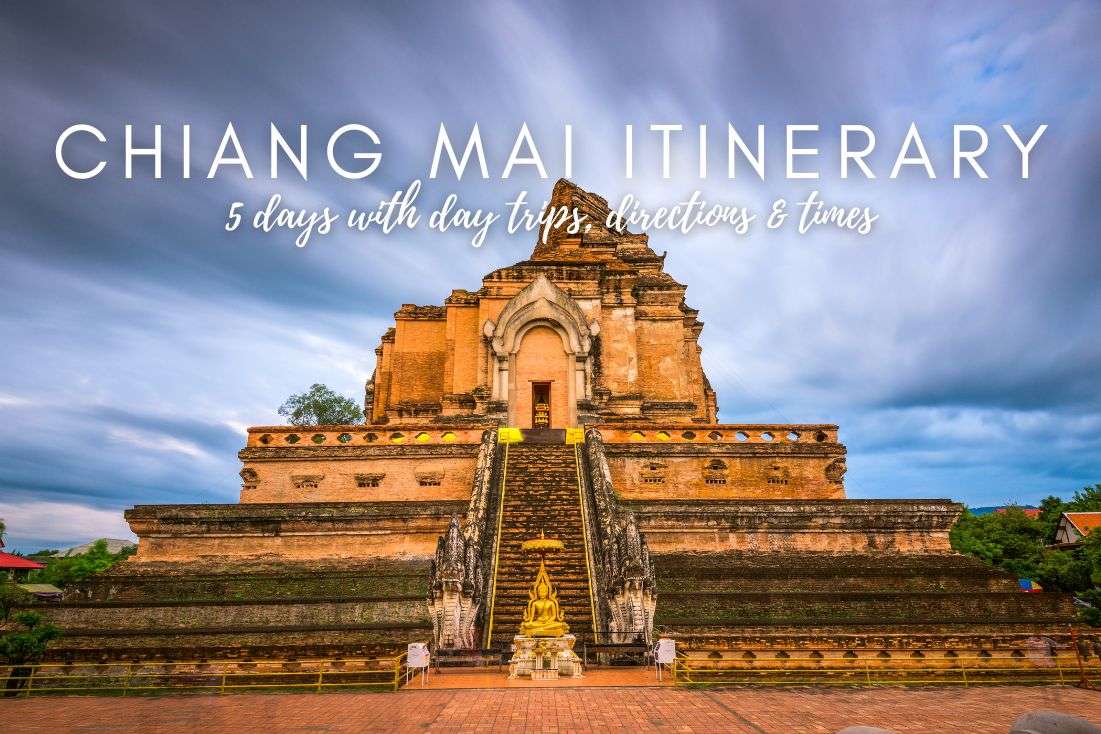
Congrats! You’ve made a fantastic decision to go to Chiang Mai, and I dare you to not rate it at the top of your list once you’re at the end of your Thailand trip (have you seen my 2-week Thailand itinerary?). I personally love Chiang Mai because it has it all: monks and temples, mountains and nature, restaurants and cafes, cute boutiques and evening markets, good prices, all the while still being a living, breathing Thai city. I know, I know, where’s the beach?! Hey, I didn’t say it’s perfect! You also can’t breathe in Chiang Mai very well for about 2 months of the year during burning season (see FAQs at the end for more burning questions, lol, see what I did there), but actually, that seems to be getting better too, so it’s just the sea that’s missing.
For the average visitor, you’ll want to spend 3 days in Chaing Mai at the bare minimum, and that is without any of the epic experiences outside of the city like walking up waterfalls and being all buddy-buddy with elephants. That’s why this itinerary covers 5 days in Chiang Mai, and they are days full of sightseeing. If you’re after more chilled out days where you contemplate your every move like a monk, go ahead and stretch the stops in this trip plan to a couple of extra days.
Top tip: You can also buy all around Chiang Mai Pass at TagThai
Everything about my travels in Thailand can be found here.
Overview of your 5 days in Chiang Mai with map
Here are all the places you’ll visit on this 5-day itinerary of Chiang Mai. Get the list in Google Maps
Here’s what I have in store for you over the next 5 days in Chiang Mai:
Day 1: Three Kings Monument, Chiang Mai City Arts & Cultural Center, Wat Phan Tao, Wat Luang Chedi + monk chat, Wat Phra Singh, Wat Suan Dok, evening in Nimman
Day 2: Chiang Man, Monk’s Trail, Wat Pha Lat, Wat Phra That Doi Suthep, Baan Kang Wat Artist Village, Wat Umong
Day 3: Cooking class, Silver Temple, Wat Buppharam, Sunday night market or alternative
Day 4: Elephant sanctuary
Day 5: Day trip to Sticky Waterfalls and Chiang Dao
Day 1 of Chiang Mai itinerary: Old Town temples and Nimman
Day 1. Get this route already mapped out on Google Maps
Main sites visited on day 1: Three Kings Monument, Chiang Mai City Arts & Cultural Center, Wat Phan Tao, Wat Luang Chedi + monk chat, Wat Phra Singh, Wat Suan Dok, evening in Nimman
Restaurant tips: The Gallery Drip Café | Baan Buri Café & Restaurant | Its Good Kitchen | Ginger Farm Kitchen
Hotel recommendations: CouCou Hotel
Further reading: Chiang Mai Best Temples
Dress code in Thai temples:
Thai temples are places of worship, and that means you need to show some respect with your attire. The golden rule is to cover your knees and shoulders. Both men and women need to adhere to the rule, but apparently girl knees are way worse than boy knees and you’ll see men in shorts in temples sometimes. A note for the ladies: Covered knees and shoulders aren’t going to cut it if you’re showing most of your torso! Also remember that northern Thailand is more conservative than than the beach hubs in the south and that there are monks walking around town, not just on temple grounds. When in Rome…
The “what if” scenario
But Petra, what if I forget and show up in shorts? Fear not! Many temples have sarongs or scarves available to borrow or rent. It’s like they know tourists sometimes leave their brains in their hotel rooms. I prefer to carry my own and I suggest the same to everyone whose wardrobe doesn’t come in the modest variety.
Day 1, stop 1: Three Kings Monument
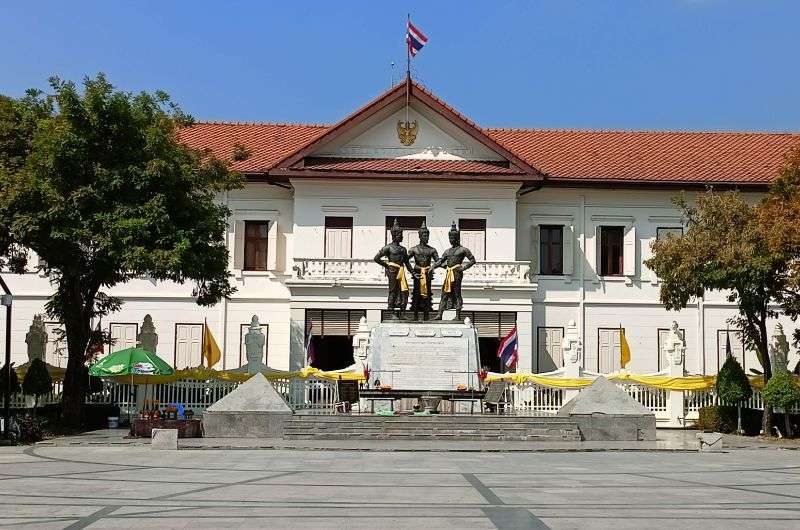
The Three Kings that founded Chiang Mai
Time spent here: 5 minutes
Price: 0
Your first stop is fittingly smack in the middle of Chiang Mai’s Old Town at a statue that commemorates the three legendary kings who played a pivotal role in the founding and development of Chiang Mai in the late 13th century. I wouldn’t make you come here if it wasn’t right in front of your next stop, so just take a moment and move on.
Who Are the Three Kings?
- King Mengrai (center): The primary figure among the trio, King Mengrai is the founder of Chiang Mai. He established the city as the capital of the Lanna Kingdom in 1296. He was pretty awesome.
- King Ramkhamhaeng of Sukhothai (right): Known for his wisdom and diplomatic skills, King Ramkhamhaeng forged a strong alliance with King Mengrai. This alliance helped to consolidate power and protect the region from external threats.
- King Ngam Muang of Phayao (left): A close friend and ally of King Mengrai, King Ngam Muang contributed to the stability and growth of the Lanna Kingdom through his support and collaboration.
Day 1, stop 2: Chiang Mai Art & Cultural Center
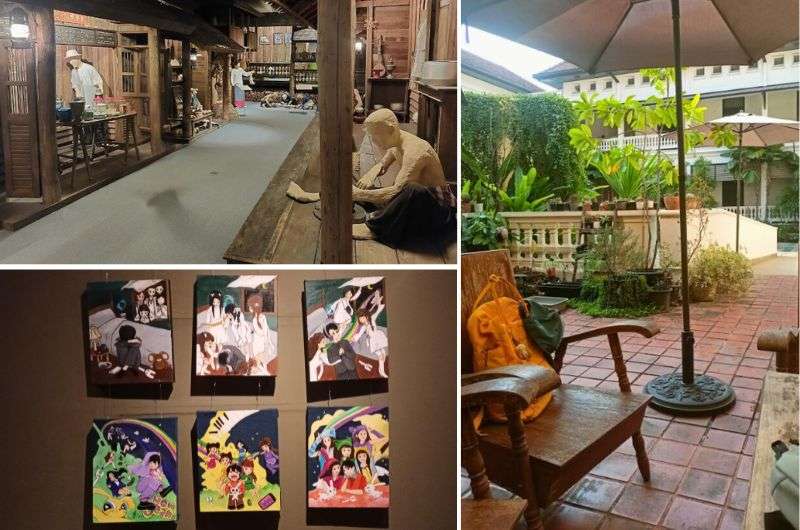
We got into Chiang Mai Art & Cultural Center for free (by accident) + you have to take time for coffee in the lovely courtyard
Distance from last stop: right behind the monument
Time spent here: 1.5 hours
Price: THB 90 (USD 2.50)
Website: Chiang Mai Cultural Heritage Centre
Located right behind the Three Kings Monument, the Chiang Mai Art & Cultural Center is housed in a beautifully restored colonial building that you can roam around freely. Or at least we did.
We got to the City Arts Centre before 8 am, still jet-lagged after flying into Bangkok from Europe two days prior and then taking the night train up to Chiang Mai. A double-whammy of reasons to be there too early. The main downstairs exhibitions were still closed, but the building in general was open, so we took a little wander. I remembered the courtyard being a pleasant little place to wander for a few minutes, so we did.
One of the art exhibition rooms on the first floor was open (or was it?), showing some delightfully weird student art. There was a pile of dust and debris on the ground, and as we turned the corner, we encountered the cleaning lady scooting more dust around. We froze, unsure if we'd get busted, but like with dogs—don't show fear and you'll be fine. She swept right past us.
Tip: We ended up taking about an hour moseying around the exhibits in this building, but if you’re a proper history and culture buff, there’s also the Chiang Mai Historical Centre just a few steps away in the next building, and the Lanna Folklife Centre is just across the road. All three fall under the Chiang Mai Cultural Heritage Centre.
When 8:30 am rolled around, we were the first ones let into the Chiang Mai Cultural Center through the door in the courtyard. It seemed like we were supposed to pay at some point, but we never reached that point, making entry free for us, accidentally. The official price is THB 90, so it’s not like I wanted to skip paying it, there just wasn’t anyplace to do so.
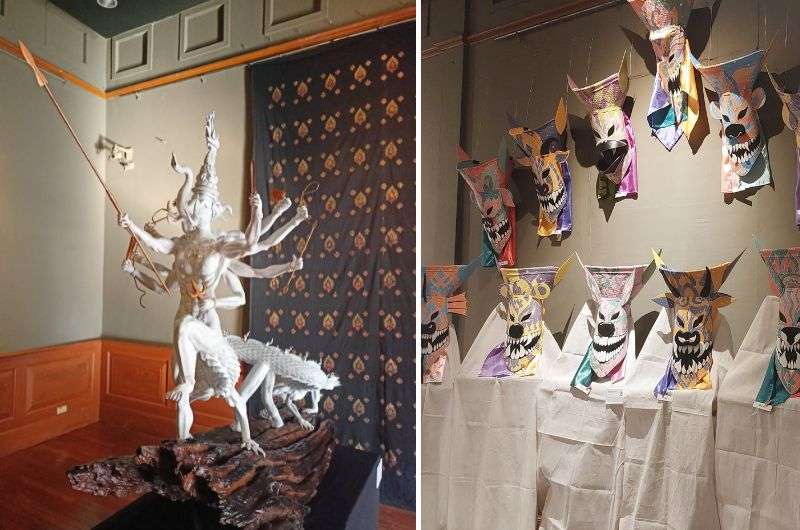
We stumbled into this exhibit of student art before the cultural center opened
Inside, the museum is a nice, compact historical and artistic exhibit preserving local heritage. Some parts are really neat and surprisingly modern. The exhibits take you on a chronological journey from the early days of the Lanna Kingdom to modern-day Chiang Mai. You'll find everything from ancient artifacts and traditional costumes to detailed dioramas and multimedia displays. The museum covers various aspects of Lanna life, including religion, trade, architecture, and everyday customs.
Coffee break
I know you’ve barely started, but this café is such a little gem for us drip fanatics: The Gallery Drip Café is in the pretty courtyard with outdoor seating. It serves ONLY DRIP COFFEE! It was like I found my people! They do sell local coffees, but I can't say I'm a huge fan. Just stick to the good stuff (African if they have it). The employees there speak great English and will happily go on and on about the origins and sourcing of the coffee they sell. Pretty insightful, honestly.
Day 1, stop 3: Wat Phan Tao
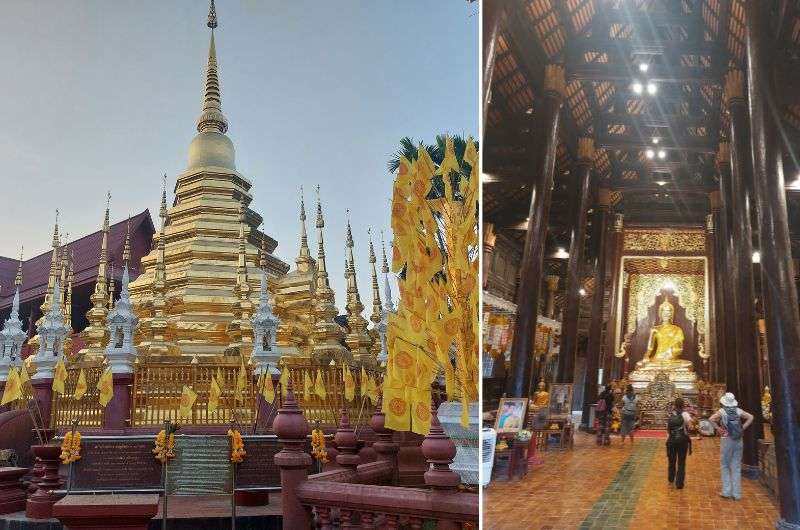
Time to visit a temple! Let’s start with Wat Phan Tao
Distance from last stop: 450 m/0.2 mi, 5-minute walk
Time spent here: 10 minutes
Price: 0
You’ve been in Chiang Mai for a few hours and haven’t visited a temple yet, what are you waiting for?! For me to take you there? Ok then!
Chiang Mai’s Old Town is packed with temples, and they’re arguably the city's main draw. I even have an entire article just about my reviews of 11 top temples in and around Chiang Mai that I highly recommend you read if you’re interested in Buddhist and Thai history or like fancy, over-the-top golden stuff with tons of Buddha statues.
Wat Phan Tao is a stunning example of traditional teakwood architecture, located right next to the more famous Wat Chedi Luang, which will be the next stop on this itinerary. Wat Phan Tao might not be as grand, but its charm lies in its unique construction and serene atmosphere. It also used to lie outside, but that’s a story of the past now.
On my last visit in 2024, I was both enchanted and a bit heartbroken by Wat Phan Tao. The teakwood architecture and the demure interior still captivated me, but I couldn’t help but feel nostalgic for what used to be its magical backyard. Once a tranquil haven with lights in the trees and a Buddha statue sitting under the canopy on the little island on the lake (water feature thingy), the backyard now has a lone tree surrounded by parked cars. Sure, times change, but not always for the better.
Anyway, now at least all the focus can be on the (deserving) main viharn (assembly hall). It’s made entirely of teak wood, with intricate carvings that highlight the craftsmanship of the Lanna period. It’s one of the few remaining all-teak structures in Chiang Mai, so look at it properly before they turn it into a garage or something.
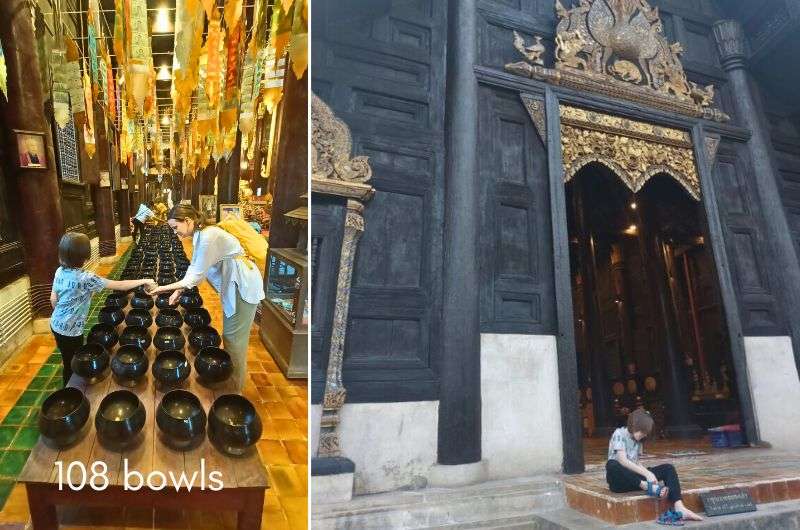
108 bowls=108 temptations
The interior is quite simple and exudes a peaceful ambiance unlike the busier and flashier temples in Chiang Mai—you’ll see, just wait.
There’s no entrance fee, but donations are always welcome. You can even “buy” a bowl full of loose change and throw one coin in each of the 108 bowls lining the left side of the temple. Why 108? According to Buddhism there 108 types of earthly desires and every Buddhist has to overcome these 108 temptations on their journey to nirvana. Putting a coin in each of the 108 bowls is said to bring good luck on the road there. I’m proud to say that I’m firmly on my way to “the place of perfect peace” because I did 108(ish) more bowls at the Reclining Buddha in Bangkok.
Next up, the big guy next door to Wat Phan Tao: Wat Chedi Luang!
Day 1, stop 4: Wat Chedi Luang
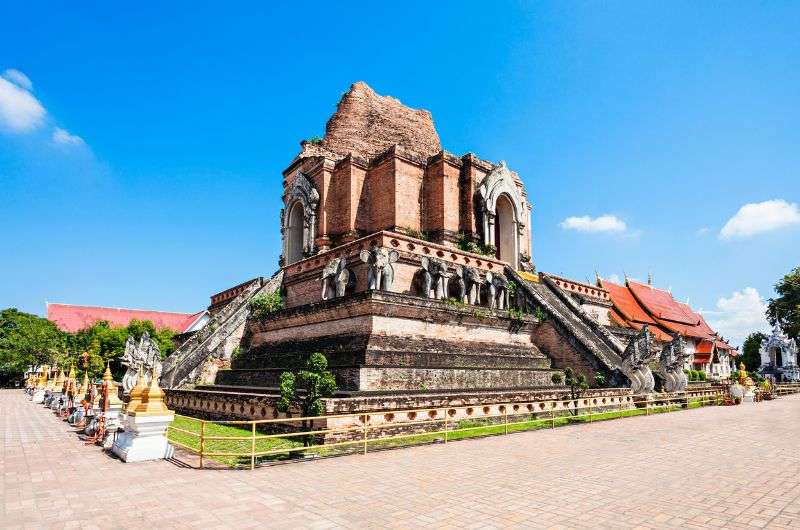
Wat Chedi Luang—the symbol of Thailand
Distance from last stop: right next door
Time spent here: 1 hour
Price: THB 50 (USD 1.40)
After the humblest temple in Chiang Mai comes one of the top dogs in all of Thailand—Wat Chedi Luang. You already know what it looks like because otherwise you came to Thailand without looking at a single picture of the country. In that case, how do you like it there? Was it all you imagined it to be?
Wat Chedi Luang’s main claim to fame isn’t the actual temple though, it’s the chedi, i.e. a bell-shaped structure that’s a prominent feature of all Thai Buddhist temples, usually built to hold relics or sometimes the ashes of the royals. And the chedi at this temple is... massive! Even with the top third gone, it’s a looker—it used to be the tallest building in the Lanna Kingdom!
The chedi also used to house the Emerald Buddha, but after the earthquake knocked a huge chunk off the chedi, they made the wise decision to move the statue. It made its way around and is now in Bangkok’s Wat Phra Kaew at the Grand Palace—see my Bangkok itinerary for details.
When you arrive to Wat Chedi Luang, you’ll buy a ticket at the ticket window for THB 50 (cards are accepted), then get your ticket checked at another ticket desk, and then walk into the temple grounds.
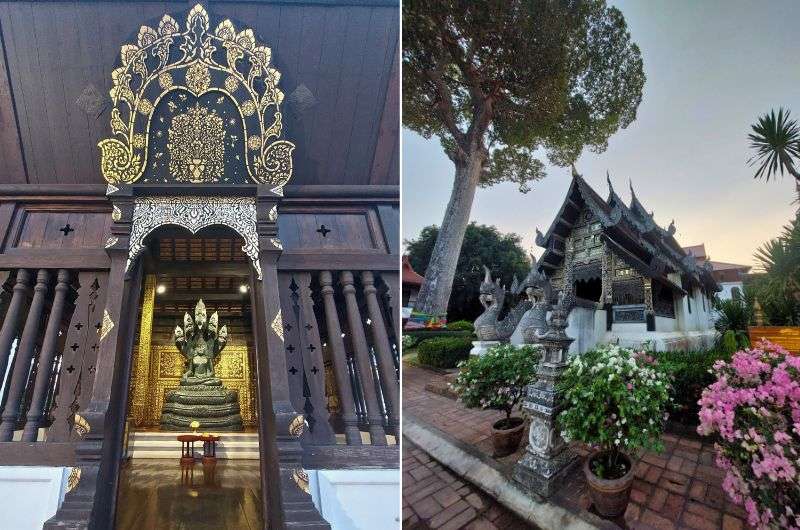
All the buildings around the chedi are beautifully decorated
Make sure you’re dressed properly! Then again, even if you’re wearing all the fabric in the world it won’t get you into the city pillar shrine that’s right by the entrance if you’re a woman. It’s men only. But you can peek in through the doors to see a very fancy interior. Also notice the three huge dipterocarp trees on the grounds that assist the city pillar in protecting Chiang Mai.
Around the central chedi there are numerous other buildings, all in a square layout around the chedi, some serving as monk’s quarters, others housing different sacred images and Buddha statues. Make sure to take time to peek in every one (not the monk’s rooms obviously!), because they’re not just your regular run-of-the-mill Buddha statues and are quite nice.
Overall, you need a solid 30 minutes to see everything at Wat Chedi Luang. But you’re not done yet…
Monk chat
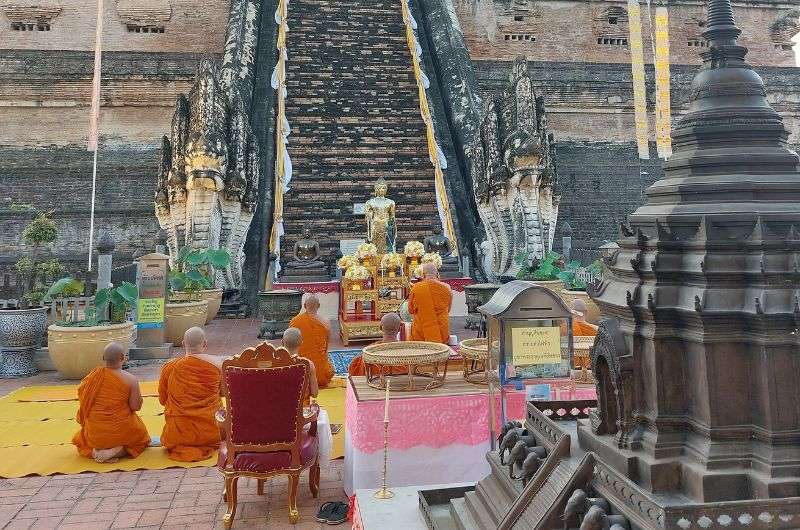
Monks, ready for a chat with you (not with these ones, they were busy with other things)!
Before you head out to your next temple, make sure to leave time for a very special experience at Wat Chedi Luang—a chat with one of the monks. There is a group of monks set up at some tables outside one of the buildings beside the chedi (you can’t miss them, there are banners with the words “monk chat” on them too), that are eagerly expecting your presence. Anyone can walk up, sit down with their very own monk, and talk to them about the ins and outs of Thai and Buddhist culture. It’s free and can last as long as you want it to, from 5 minutes to an hour (not sure what they do if someone just never gets up and stays there longer). Women can talk to them too, in case you were wondering. You them a favor and prepare some interesting questions beforehand, I can only imagine what it’s like answering the same thing over and over again. Remember that these are mostly novice monks though and their level of English may be very basic. This is meant to be a cultural exchange and also an English lesson for them. Have fun!
Day 1, stop 5: Wat Phra Singh
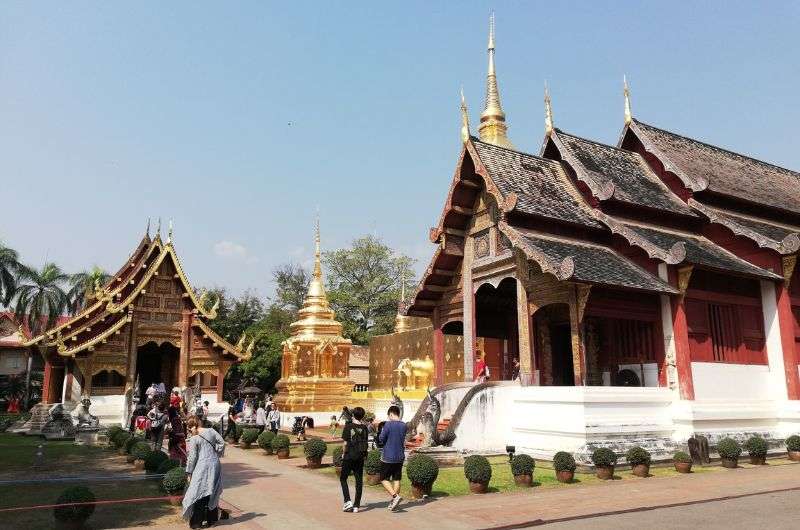
The golden Wat Phra Singh
Distance from last stop: 700 m/0.4 miles, 10-minute walk
Time spent here: 30 minutes
Price: THB 20 (USD 0.50)
Next stop—another temple! You really shouldn’t be surprised that many of the places you’ll see on this itinerary are temples, because that’s one of the highlights of Chaing Mai. But it’s not just the temples, but just walking between them in Old Town is a pleasant experience, with the next coffee shop or restaurants never too far away, so make sure you enjoy the journey just as much as the destinations! Hey, when all else fails, you can always stare at the “unique” setup of the electric wires. Those never cease to entertain me.
At Wat Phra Singh, you pay a small free to enter (THB 20) and then you wander. Also, you get blinded by the light reflecting from all the gold! This temple was built in the 14th century to house the ashes of the king’s his father, and they didn’t spare any expense, apparently.
Wat Phra Singh is incredibly elegant, which you’ll notice not only when looking at the building exteriors, but maybe even more on in the interiors. There are so many details that you could stand there and stare at walls for dozens of minutes at a time. If you want to learn more about Buddha’s previous lives, these walls will tell you all about them.
And then you’ll find the wax monks. And if you’ve never seen them before, I promise you’ll think they’re real, and then you’ll do a double take and, while trying not to stare too much in case they turn out to be real, you’ll try to see if they’re breathing. Now, there can be real monks sitting in temples too, ok, so don’t do anything disrespectful or stupid! The wax ones honor past monks that were, err, very good monks. So be nice.
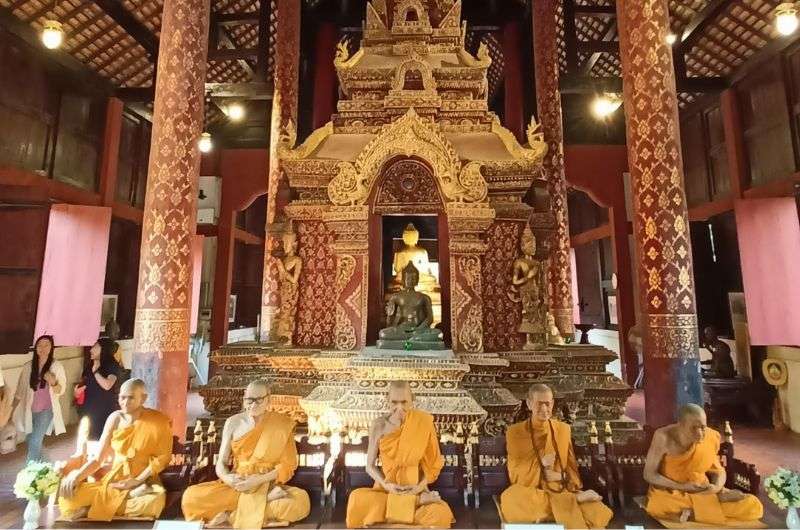
You see? They look so real...
You’ll probably be done in 20 – 30 minutes at Wat Phra Singh, and you might be working up an appetite by now, too, so let’s see what your options are:
Lunch break options
If you want to improvise, go ahead, you can’t throw a lotus flower in Chiang Mai without hitting a temple or a restaurant, so you’ll have plenty of options. Seeing that you’re not next to one of the most famous temples in Chaing Mai though, a good number of the restaurants you’ll see will be of mediocre quality. I always like to take a quick peak at the reviews in Google Maps to make sure I’m not completely off in my pick (filter by 4.5 or higher rating to find the top places—they come in all price brackets, so no worries if you’re not looking for a fancy affair).
Baan Buri Café & Restaurant is a good choice if you can’t decide between western and Thai and like a brunch-style place. Who said you can’t have pancakes with your Khai Soi?? Bonus points for lovely design and tasty coffee (drip available).
Right across the street from Baan Buri is Its Good Kitchen, a simple, small Thai restaurant that makes really good Thai food. Beware that spicy means SPICY! I don’t care what anyone says, eating at these little spots always adds to the experience. They’re probably using their grandma’s recipes and everyone working there is in the family. Also, the prices are lovely!
Day 1, stop 6: Wat Suan Dok
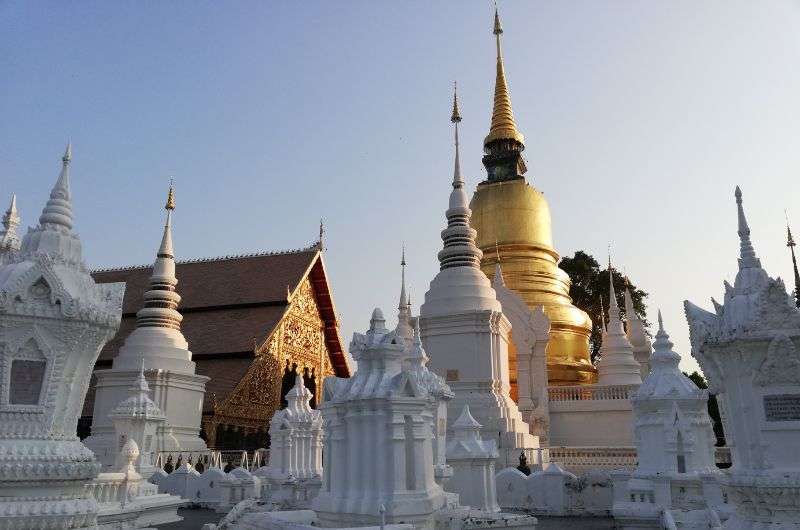
The beautiful white and golden Wat Suang Dok
Distance from last stop: 1.5 km/0.9 miles, 20-minute walk or 5-minute Grab
Time spent here: 45 minutes
Price: 0
First, a little note on Thailand’s weather: If you feel the need to go freshen up at your hotel before continuing on this lovely Chiang Mai itinerary, do that. I certainly did. We went in March last time (2024) and even the locals were saying how unbearably hot it is this year. We had temps of minimum 37°C (99°F) every day and it’s not like starting early in the morning helped for too long—it was full-on heat by 8:30 am. A little afternoon siesta & coffee break was our daily ritual, because sightseeing sucks when you’re feeling like a wilted lettuce leaf by noon.
Tip: If you don't want to feel like you’re melting every day, skip traveling to Chiang Mai (or anywhere in Thailand) between March and May, when the heat is insane. Next time, I’ll probably aim for November-ish to get lower temps, lower chance of rain, but still not extreme tourist season (December to February are the most popular months). I’ve never gone in the summer months of June to September, because everybody warns you about the rain, but it turns out it probably isn’t as bad as it sounds. I’ll let you know when I try it out!
Then, after you’ve scrubbed off the sweat and restored your will to live, head over to Wat Suan Dok. It’s outside of the city center, so I recommend taking a Grab. It’s not far, but again, the heat! You just put on a clean shirt, so no need to get it sweaty straight away.
The temple is stunning at sunset, with the white chedis glowing in the soft evening light. If you’re there in peak tourist season (December to February-ish), the sun sets around 6 pm. Not to mention there’s something magical about the cooler evening air (a relative term, of course) that makes the whole experience feel less like a survival challenge and more like a serene end of your first day in Chiang Mai.
Like at many of Thailand’s temples, the grounds are open all the time, but the temple interiors close around 6 pm at the latest (some as early as 5 pm). It’s a good idea then to get to Wat Suan Dok by 5 pm so you can wander around the temple buildings while you still can.

Wat Suan Dok serves also as Thailand’s largest university for Buddhist education
We saw plenty of monks at Wat Suan Dok, including inside the temple and outside, since this is also home to Thailand’s oldest university focused on Buddhist education. It’s like visiting a university town, but with everyone wearing saffron robes and a lot less beer.
Then, get lost in the sea of white chedis. These striking structures are the resting places for the ashes of the old Lanna royal family. Since you’re basically in a cemetery, make sure to behave accordingly. It’s easy to spend ages just taking photos here, especially if the sun is just setting.
Day 1, stop 7: Nimann
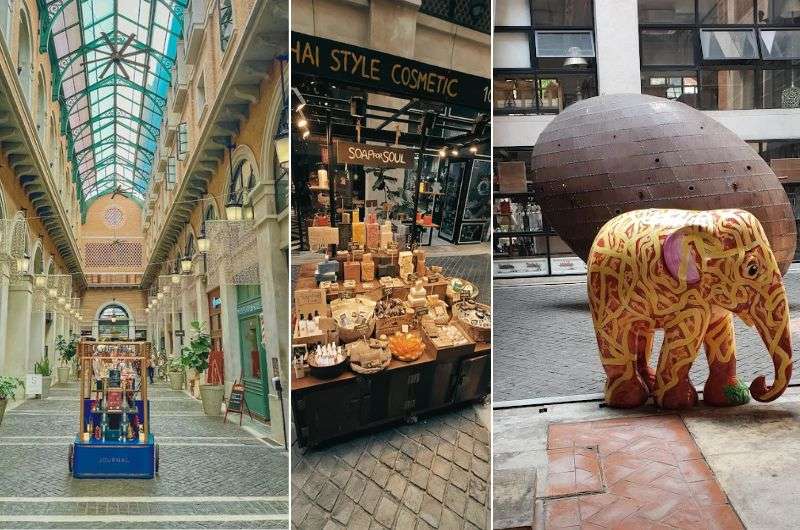
One Nimman
Distance from last stop: 1.5 km/0.9 miles, 20-minute walk or 5-minute Grab
Time spent here: as long as you want
Price: 0
To end your 1st day in Chiang Mai, you’ll hang out in the trendy neighborhood of Nimman (named after the main Nimmanahaeminda Road). There’s not much to do there but eat and drink, but hey, is there ever a bad time for that? There are also boutiques, galleries, night markets, and establishments of all types to suit every taste.
The first spot to kick off your evening would be One Nimman, which is officially a shopping mall, but don’t side-eye me just yet—it’s a beautifully designed blend of modern and traditional and feels more like a charming European village square than a commercial center, with its cobblestone paths, open-air courtyards, and brick facades. One Nimman is perfect for (window)shoppers who appreciate unique, high-quality goods. You’ll find an array of boutique stores and small stands offering everything from handmade crafts and local designer fashion to quirky home décor and artisanal products.
When we visited, there were fairy lights and live music in the courtyards with people chilling and browsing in the evening. There are also plenty of places to grab a dinner, like the bohemian (and Michelin-approved) Ginger Farm Kitchen. There’s always an art exhibition or pop-up event happening at One Nimman, so you’ll no doubt have a good time.
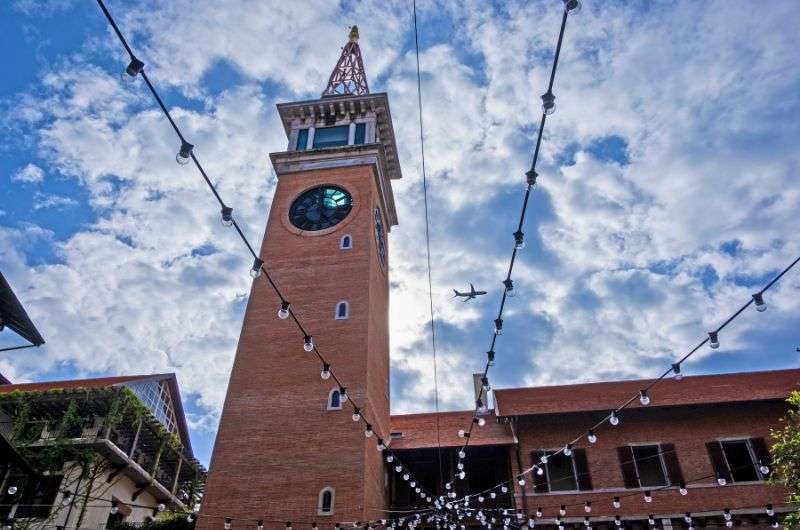
Nimman is the trendy neighborhood where you’ll find many of Chiang Mai’s expats
Or, for a change of scenery, head across the street to Think Park, which is like a little slice of Japan. It even has its own Hachiko statue (read about the original goodest dog statue near Shibuya Station in Tokyo)! This place gives more night market vibes, complete with little chairs and a myriad food stalls. Unless you forgot to eat at One Nimman, you can just walk through to the area behind the market that is like a maze of tiny bars and, once again, little shops. I especially loved the huge tree in the middle, wrapped with colorful fabric, reminding me that this is, in fact, Thailand. You’ll find somewhere to get drinks and people-watch. But don’t stay too long, you’ve got a hike in the morning!
Ready to hit the sack? This seems like a good time to talk about the best neighborhoods in Chiang Mai to book a hotel in. Read on…
Best area to stay in Chiang Mai: Old Town vs Nimman vs outside Tha Phae Gate
In summary, Chiang Mai Old Town is more traditional and full of temples (and tourists), Nimman is the trendy neighborhood full of restaurants, shops, and expats. Then there are the areas just outside of the moat, the most popular among visitors being the streets closest to Tha Phae Gate in the east. I’ve stayed in all of them, all are good options, but Old Town’s the best, especially for first-time visitors in Chaing Mai.
Hotel choice in Chiang Mai Old Town: CouCou Hotel
Coucou Hotel: Small hotel (I don’t like big ones!), just barely still in Old Town (north), close enough to all the Old Town temples, but also right at the moat, making getting out of tourist central easy peasy.
The area: Chiang Mai’s Old Town is a perfect, formerly walled square in the middle of the city. I like it because you have a literal moat that keeps you within bounds of where most of the tourist activity happens. Unless you’re in the very center close to the main temples like Wat Chedi Luang, you actually find plenty of small, quieter streets, so you don’t need to fear you’ll feel overwhelmed by staying in the crowded Old Town.
Hotel choice in Nimman: G Nimman
G Nimman: You can only stay here if you’re trendy enough. That’s all I can say, just look at the photos!
The area: Nimman, short for Nimmanhaemin Road, and encompassing an entire area that is around that road, is Chiang Mai's trendy and bustling urban hub with a youthful energy. Forget temples, think shopping, chic cafes, and the highest concentration of foreigners living in Chaing Mai. The neighborhood is also known for its lively (but not rowdy) nightlife. Art lovers will enjoy the numerous galleries and street art that add to the area’s creative vibe.
Hotel choice near Tha Phae Gate: Villa Tha Phae
Villa Tha Phae: Super cute hotel with just 6 rooms and a small, luscious garden, our room had direct access to the pool, which felt luxurious (but the water was a tad on the cold side).
The area: I’ve also stayed just outside of the Old Town near Tha Phae Gate, and what I likes is that it’s an entire little tourist enclave that isn’t as busy as the center of the Old Town. But it’s just for eating and sleeping, so you still made your way over to the Old Town whenever you wanted to see anything. Plus, you need to make your way all the away across (or around) Old Town to reach most of the other must-sees outside of the city center, which is a pain—Chiang Mai’s traffic isn’t fun! and it’s li, so I’d say the main reason to choose this location is a slightly better price point.
Day 2 of Chiang Mai itinerary: Doi Suthep
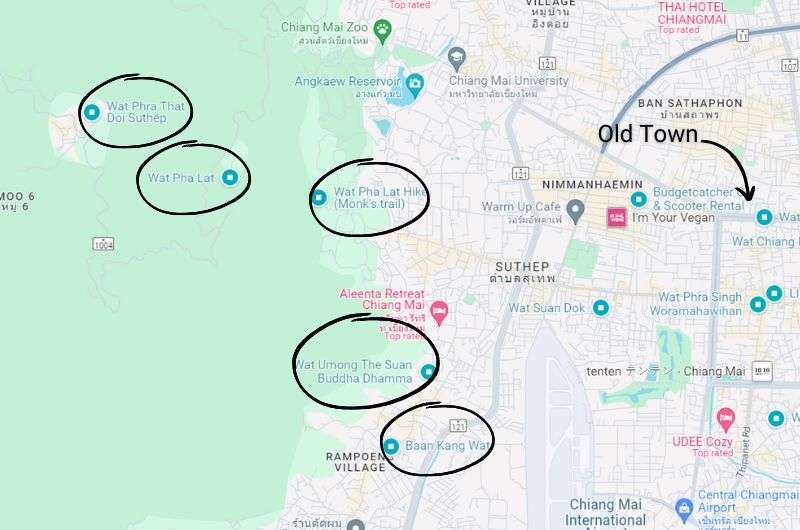
You’ll spend your second day in Chiang Mai near or on Doi Suthep mountain
Main sites visited on day 2: Chiang Man, Monk’s Trail, Wat Pha Lat, Wat Phra That Doi Suthep, Baan Kang Wat Artist Village, Wat Umong
Hotel recommendations: G Nimman
Further reading: Monk’s Trail Guide
Rise and shine! You’ll want to get up early today because unless you’re visiting Chiang Mai in an unprecedentedly cold time, it’s best to tackle the hiking part of the day before the heat gets too unbearable. Today, we're diving into a mix of temples, nature trails, and Thai artistic flair. Ready to take you through an action-packed Day 2 in Chiang Mai!
Even though you’ll be hiking up a mountain trial, make sure to dress modestly. This trail can still be used by monks, and it leads to a temple, so you don’t want to be caught wearing a sports bra and short shorts.
Day 2, stop 1: Wat Chiang Man
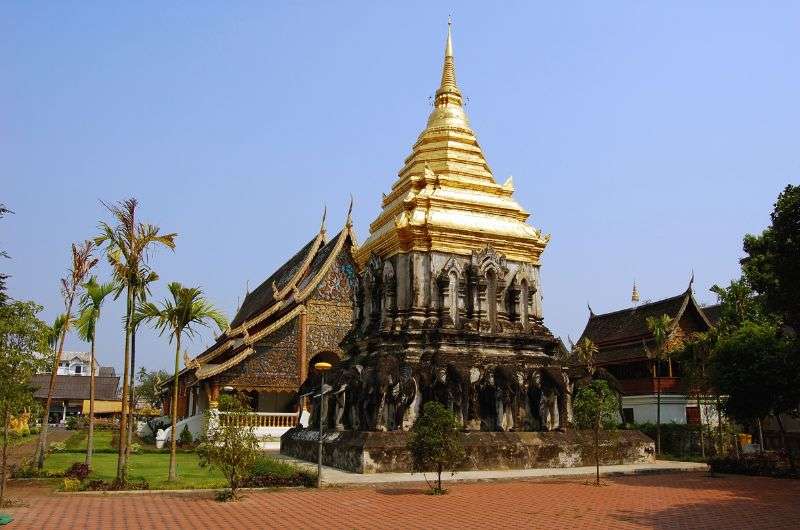
Wat Chiang Man —the oldest temple in Chiang Mai
Time spent here: 30 minutes
Price: 0
Our first stop is the oldest temple in Chiang Mai, Wat Chiang Man (note: this makes the most sense logistically if you’re staying at CouCou Hotel or another hotel located in the northern area of Old Town). If you're an early bird like me, aim to get there at the crack of dawn. Not only will you beat the crowds, but the morning light makes everything look absolutely magical.
Wat Chiang Man was founded by King Mengrai in 1296, boasting some of the city's most ancient and revered Buddha images.
The first thing you’ll notice when entering Wat Chiang Man is the elephant chedi. The grandaddy of a chedi is supported by a circle of stone elephants that look like they were born there and then moved on to bigger and better things, like holding up the chedi at Wat Chedi Luang. Chedis are built to hold relics, and this one holds… Buddha’s hair! Unexpected, isn’t it?
Moving on, the intricate wooden carvings on the front of the smaller viharn look like lace and are a sight to behold. Inside, you'll find the Phra Kaew Khao Buddha made of crystal, believed to date back to the 15th century (depending on who you ask, some like to believe it’s way older than that), and another ancient Buddha image said to have rain-giving powers. You’ll need to try really hard to see them, since they’re protected in the little jail behind the main large Buddha in the hall.
In the larger viharn, you’ll find (among many, many others again at the main alter) the oldest Buddha statue in all of Thailand, with the year 1465 CE engraved on its base. He’s the one holding the alms bowl.
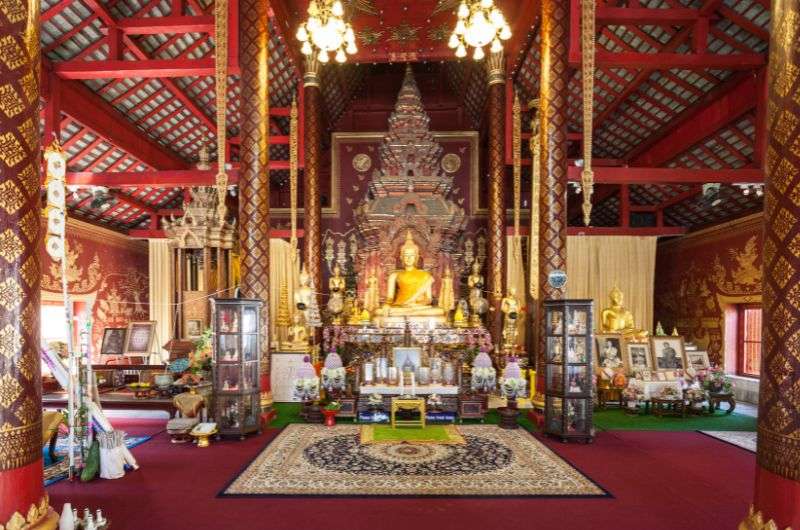
This statue was moved here from Wat Chedi Luang
Also make sure to notice a small building sitting in the middle of a little pond. The water protects the ancient scriptures written on palm leaves housed inside from bugs and, well, humans. Apparently, a bridge can be added when needed, but the less people are allowed in there the better.
Optional breakfast stop, because pancakes!
I love pancakes, and pancakes love me. And the pancake offerings and perfect location close to Wat Chiang Man makes Blue Diamond Breakfast one of my all-time favorite breakfast spots in Chiang Mai. I like a great hotel breakfast just as much as anyone, but seriously, if you haven’t tried the tea and pancakes at Blue Diamond, you haven’t truly lived. Sure, they have tons of other options on the menu, but I just can’t resist a good, plate-sized pancake! With maple syrup, obviously. Preferably eaten in the lush garden.
They open at 7 am. Then again, they’re open until late, so I guess you could have pancakes for dinner too, why not!
Day 2, stop 2: Monk’s Trail
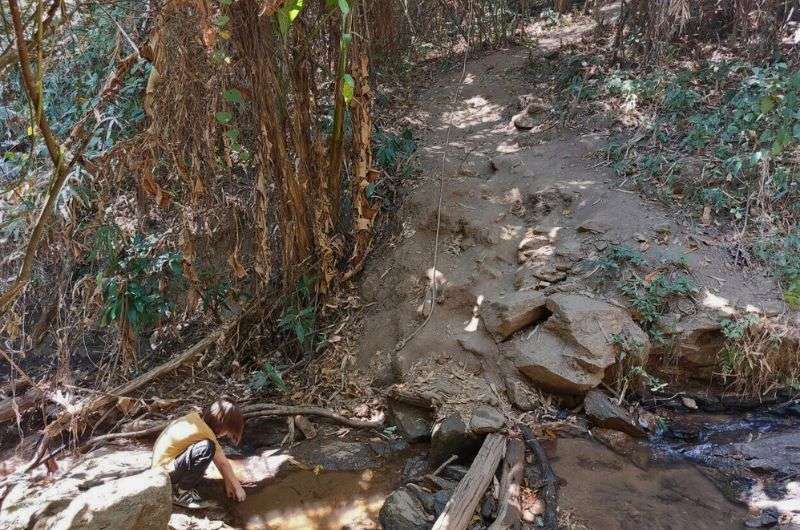
The Monk’s Trail is easy to follow, but there are some steep bits thrown in for good measure (this is from the side trail in the northern section—read my Guide to the Monk’s Trail for details)
Distance from last stop: 7 km/4.4 mi, 15-minute drive
Time spent here: 1 hour
Price: 0
With a satisfied belly, it’s time for a bit of adventure. Grab a Grab and head to the start of the Monk’s Trail. This hike leads to Wat Pha Lat, a temple in the middle of the jungle (ok, there’s a road that leads there too, but just ignore that part), so it’s not only a great way to get some exercise, but it’s also steeped in history and natural beauty. A Grab from Old Town will cost around THB 150 and take just 15 minutes.
>> Read my full Monk’s Trail guide for practical details and insider tips <<
I remember hiking this trail five years ago when it was marked only by saffron cloth around some trees. Let's just say, we got hopelessly lost (the full story is at the end of my Monk’s Trail Guide). Thankfully (or regretfully?), it’s much easier to navigate now and should take about 45 minutes to reach Wat Pha Lat.
Hike length: 3 km (1.8 mi) out-and-back
Elevation gain: 160 m (520 ft)
Difficulty level: Easy to moderate (some steeper sections and tougher terrain)
The trailhead is next to the Army Radio and Television Channel entrance. Just look up "Wat Pha Lat Hike (Monk's Trail)" on Google Maps.
Heads up: Google Street View might show cars and scooters at the trailhead, but as of February 2024, part of the road approaching the trailhead is closed to vehicles. Our Grab dropped us about 350 meters (0.2 miles) from the trailhead. No biggie—it’s a quick 10-minute walk.

The Monk’s Trail used to be marked simply by saffron cloth around trees that were sometimes hard to find, but now it’s a very clear with large colorful banners hanging along the entire route
You'll pass a little checkpoint where the ladies smile and wave—don’t stress, just smile back. We thought they want us to pay, but apparently it was just a good place for them to tourist-watch.
Then, look for the wooden gate; it’s the new, clearer entrance. See the green map? You’re on the right track. Ignore the map (it’s useless) and follow the colorful banners marking the trail. No more guessing games with saffron cloth. Can’t lie though, it takes away from the magic of finding your way through the jungle to a semi-secret temple. These days it’s very easy to navigate, despite being uphill the entire time.
Feeling full of stamina? A few steps before you reach Wat Pha Lat, you’ll notice a trail to the left with a sign telling you it’s a 400 m (0.24 mi) climb up to Wat Anagami. On many, many dirt stairs, mostly. They are lined by makeshift bamboo railings and ropes some of the way, which makes it a tad easier, but you’ll get your hearrate up, that’s for sure. Note that the temple at the top is nothing special. We went and it was good fun, but it’s not a must-do.
Day 2, stop 3: Wat Pha Lat
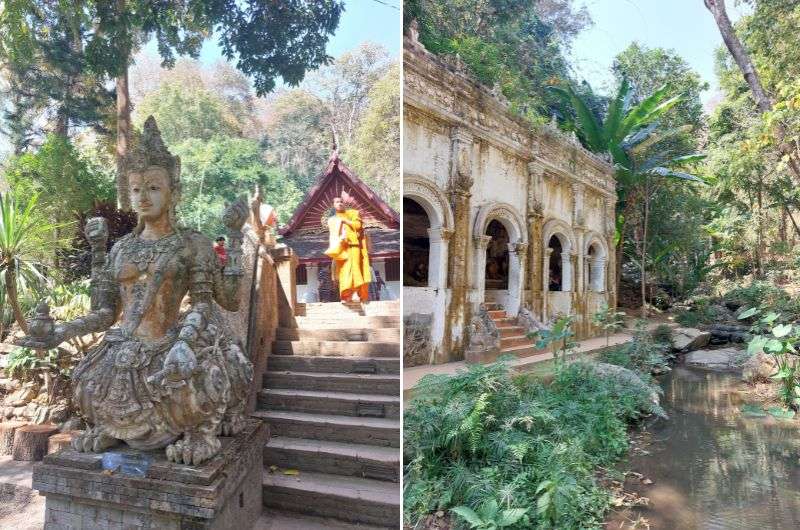
Hike through the jungle to Wat Pha Lat
Time spent here: 45 minutes
Price: 0
One you arrive to Wat Pha Lat, you’ll feel super special. You’ve made it up there just like the monks do! Or rather, they now use a different path, which is understandable seeing how many tourists use this one these days. It’s not crazy busy, but it certainly doesn’t feel very sacred anymore.
Wat Pha Lat is “hidden” in the jungle, complete with a stream and a waterfall. It’s never too crowded, though there is a road leading to it, so even those that choose not to hike can easily visit (too bad for us walkers, huh?).
This place feels incredibly magical, especially if you’ve experienced the struggle of finding it back in the day. The serene setting and the sound of water make it a perfect spot for some quiet reflection. And a snack, which I recommend taking with you and eating on the rocks by the falls.
Tip: There may or may not be some food stalls at the road entrance to Wat Pha Lat, but it’s not certain they’ll be open, so make sure to bring your own. The first time I went, they were closed, and the other time there was a big celebration, so I couldn’t tell how many refreshment options there would’ve been without the party.
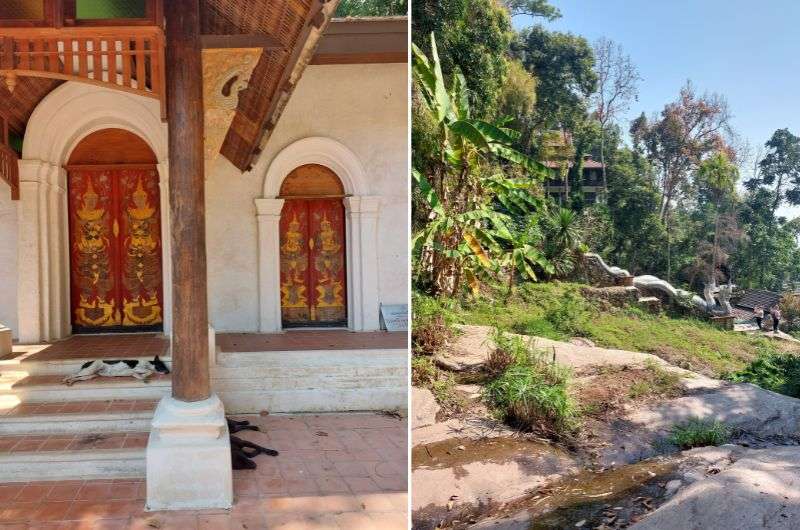
I bet the monks are really doing well in these architectural gems surrounded by nature
The temple’s architecture blends seamlessly with its natural surroundings. You’ll find beautiful stone carvings, ancient statues, and traditional Lanna-style structures tucked amidst the greenery. The stone pathways and bridges that crisscross the temple grounds add to its charm, as do the monks who actually live here. I’m sort of jealous, not gonna lie. Wait… are monks allowed to eat pancakes?? How about drip coffee? No? Ok, never mind.
Wat Pha Lat is a functioning monastery where monks go about their daily lives. It used to be just a resting spot on the hike up to Wat Phra That Doi Suthep, but now that there’s a road connecting everything, monks are able to live here permanently. It’s common to see them around the temples and tending to the temple grounds. Be respectful of the monks and their space and keep noise to a minimum.
Day 2, stop 4: Wat Phra That Doi Suthep
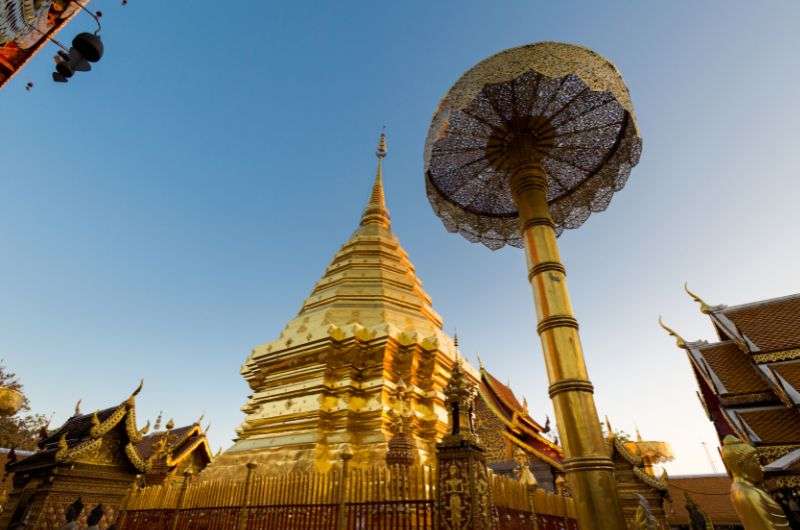
Wat Phra That Doi Suthep— another golden architectural gem of Chiang Mai
Distance from last stop: 6.5 km/4 mi, 15-minute drive on a winding road
Time spent here: 45 minutes
Price: THB 30
Next up is the most revered temple in Chiang Mai, Wat Phra That Doi Suthep, perched at the very top of Doi Suthep (the mountain standing to the west of Chiang Mai). While you have the option to hike up there from Wat Pha Lat (which would take about 1.5 hours), given the throngs of tourists shuttling up and down all day long, I recommend taking the road like everyone else. You can hop on a songthaew (red truck) or take a Grab from the road just above Wat Pha Lat. Those red trucks are usually full by the time they get going up the mountain, so finding one that has room for you may take a while. In pre-Grab times they would charge ridiculous amounts to tourists (me), trying to get a spot on the truck while already in the middle of the mountain road, because, what else am I gonna do, walk? Grab has mostly fixed this problem.
Upon arrival at the mayhem that is the entrance to the temple (or rather the stairs to it), you’ll be dropped off in a bustling parking area full of tourists and vendors. Your first task is to make your way up the long dragon staircase—about 300 steps. It’s a bit of a workout, but you’ll be dodging children in traditional clothing asking for money along the way, which adds to the experience. If stairs aren’t your thing, there’s a cable car available for a small fee. I’d only use it if you honestly can’t make it up the stairs, there’s nothing special about it.
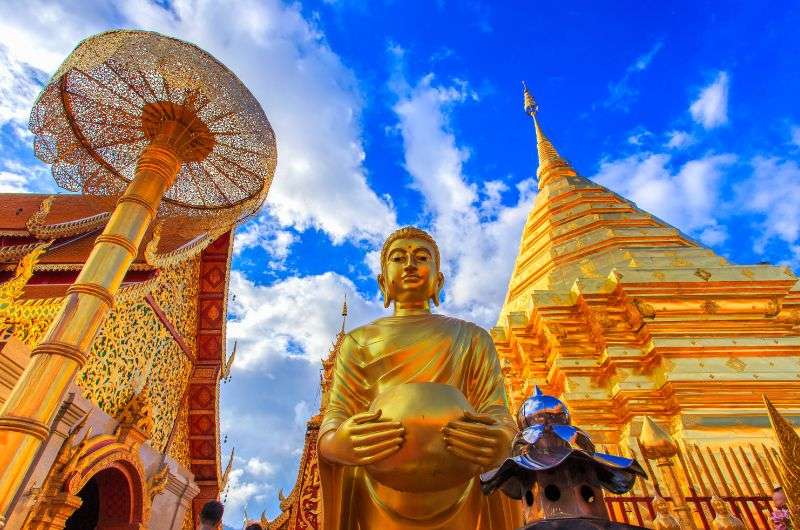
Wat Phra That really is that shiny!
Once you reach the top, you’ll pay an entry fee of THB 30 and remove your shoes. The first thing that will hit you is the sheer amount of gold. Actually, the first thing that hit me was the sheer amount of shoes and the thought I’d never find mine again, but then I managed to move past the anxiety to better, fancier things. Wat Phra That is SHINY! The central chedi is a massive, gleaming golden spire that catches the sunlight brilliantly. Every corner of the temple grounds seems to sparkle with golden statues, shiny pagodas, and beautifully adorned shrines. Too much? Definitely! But is it an experience? Sure!
One of the highlights of Wat Phra That Doi Suthep is the panoramic view of Chiang Mai from the terrace. It’s a perfect spot for photos, though finding a moment without other tourists can be a challenge. The temple grounds aren’t huge, but if you take your time to explore everything, you can easily spend an hour here. There’s also a café on site that could fill up some of that time.
When you’re done wandering, go try to find your shoes and head back down the dragon stairs.
The Legend of the White Elephant

Hear me out about the white elephant legend
Wat Phra That is famous for the legend of the white elephant. According to the story, a sacred relic of the Buddha (his shoulder bone) was placed on the back of a white elephant by a revered monk. The elephant was then set free to wander, as the monk believed it would choose a sacred spot to house the relic. The elephant climbed up Doi Suthep, resting midway at what is now Wat Pha Lat. Because of this it became a sanctuary and resting place, and later a temple and monastery.
After chilling at Wat Pha Lat, the white elephant continued its ascent until it reached the peak of Doi Suthep. There, it trumpeted three times before lying down and passing away at the spot where Wat Phra That Doi Suthep now stands. This event was taken as a divine sign, and the temple was built to enshrine the sacred relic.
Fun fact: Actually, the bone was broken into two pieces before the elephant started walking up the mountain. The other piece is now enshrined at Wat Suan Dok, a temple you visited on this itinerary yesterday. Cool, huh?
Day 2, stop 5: Baan Kang Wat Artist Village & Lunch

Time for food! Very local cooking arrangement and delicious taste
Distance from last stop: 16.5 km/10.4 mi, 30-minute drive
Time spent here: 2 hours including lunch and coffee breaks
Price: 0
After soaking in the stunning views and rich history of Wat Phra That Doi Suthep, it’s time to switch gears and dive into Chiang Mai’s local arts scene. Hop in a Grab and make your way about 30 minutes to Baan Kang Wat, a charming artist village where creativity flows as freely as the iced coffee. This place is a haven for local artists where you’ll find a variety of shops and ateliers where they create and sell their work. And food, there’s food too. You didn’t think I’d let you starve, did you?
Don’t expect a real village, it’s more like a small, artsy neighborhood with one tiny creative space next to another. Obviously, they expect visitors, which doesn’t make me angry, because you know what that means, coffee shops! I love seeing traditional culture and local way of life, I really do, but if I can also eat and drink well while I’m there, then I can’t be mad at a little commercial involvement. It’s not hipster or chic and trendy (aside from some of the coffee shops), so don’t make the mistake of thinking this is just another outdoor shopping area like in Nimman. We also saw very little Western tourists at Baan Kang Wat.
As you try not to get lost in the maze of picturesque lanes, you’ll find an array of shops and ateliers where local artists create and sell their work. This is why I like this place, because it’s a real artist community where they really try to make a living doing what they do, it’s not just selling things they bought at a cheap market full of Chinese imports. From paintings and ceramics to textiles and jewelry, there’s a lot to be discovered.
What’s even better? Many artists offer hands-on workshops. I tried my hand at making a mosaic placemat! And it took me way longer than I thought it would. I should’ve known I was in trouble when they showed me the huge variety of mosaics to choose from. I was assisted by the very helpful shop owner and his very unknowledgeable mother. She was nice though!

Baan Kang Wat Artist Village is great for coffee, eating and strolling; I made myself a mosaic placemat for my coffee cup, the final product is pretty cool!
The village itself is picturesque, with lots of shade (score!), cute little lanes, art installations, and cozy cafes and a couple of restaurants too. We chose one that was just a few outdoor tables and a very rustic setup with zero English spoken. The food was very nice. I can’t even see it on Google Maps, so I can’t link it for you, but if you keep right from the main entrance and walk by the pond in the middle, you’ll see it.
Now comes the hard part: Getting out of there. Since Bann Kang Way is way outside of Chiang Mai Old Town, away from almost any other place of tourist interest, we got stuck there. Grab kept coming up with nothing and red trucks we nowhere to be found. If this happens, you could just walk to your next stop. Or, keep trying. We flagged down a truck eventually!
Day 2, stop 6: Wat Umong Suan Buddha Dhamma aka Tunnel Temple
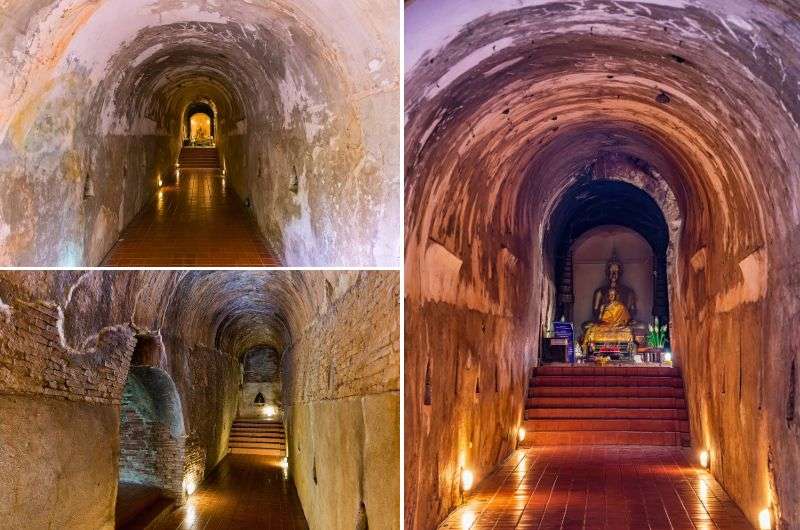
The tunnels at Wat Umong Suan Buddha Dhamma are the clear hightlight of this temple
Distance from last stop: 16.5 km/10.4 mi, 30-minute drive
Time spent here: 2 hours including lunch and coffee breaks
Price: 0
Like I mentioned, getting from your last stop at the artists village to Wat Umong Suan Buddha Dhamma may or may not be an adventure in itself. But even if you can’t find a taxi of some sort, walking 1.5 km (0.9 mi) wouldn’t be that bad. Hey, at least you’d get a better look at a less touristy part of Chiang Mai! Make sure to get there by 4 pm so you have time to look around before they close at 5 pm.
At Way Umong, you’ll feel like you’re a world away from Chiang Mai’s Old Town. Which, despite my love of Chiang Mai, is sometimes necessary because the Old Town can be a lot. The forest setting is lush and quiet. Established in the late 13th century by King Mangrai, this temple is renowned for its meditative atmosphere (it was literally built as a meditation retreat for monks) and unique architectural features, aka the underground tunnels.
You’ll see the pond shortly after you walk onto the temple grounds. It’s a nice spot with koi fish that you can feed. But, um, I skipped that activity and fled for the tunnels instead (something about a snake, you can read about that “fun” experience in my Best Temples of Chiang Mai article).
The tunnels are what will etch Wat Umong firmly into your memory—when's the last time you saw Buddha statues at the end of brick-walled underground tunnels?! For me, that would be never. It’s a maze of meditation cells down there. The way they are lit adds to the unique atmosphere and makes the experience unforgettable.
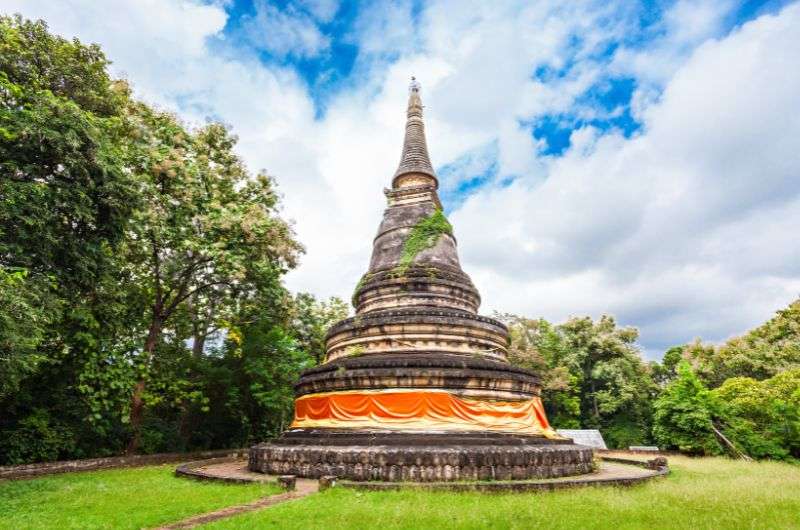
Above ground part of Wat Umong Suan Buddha Dhamma
Of course, there’s the main hall and a chedi with some Buddha bits inside, but quite frankly, they were overshadowed by the, errr, other memories I made on this site. I mean the tunnels. Throughout the temple grounds, you’ll find “talking trees” with Buddhist proverbs and sayings attached to them, some more inspiring than others. My, um, favorite quote was in the open-air museum on site that reminded me that “The lives of sentient beings are like clay pots, destined to break, sooner or later”.
You’ll also want to make a brief stop at the replica of an Ashoka pillar. You can read a little about the establishment of Buddhism in northern Thailand by King Mangrai on the plaque next to it.
Last thing to do before returning to your hotel is finding a way to get there! Kidding aside, getting a Grab to pick you up at Wat Umong was pretty easy.
Dinner on day 2 and an illuminated Wat Chedi Luang
Get cleaned up and head out for dinner. You need to see Wat Chedi Luang lit up at nighttime at least once during your stay in Chiang Mai, so why not head out in that direction. The temple closes at 5 pm, but the grounds are open until 10 pm.
Two restaurants that aren’t tourist traps and actually cook great food in pleasant surroundings are LINK Cuisine and Always Thaifood. Both have fantastic food, the former with a more classy interior and fairy lights in the garden, the latter having a more lively chillaxed vibe, complete with hundreds of lanterns and colorful umbrellas (on the ceilings).
Day 3 of Chiang Mai itinerary: Cooking class, outer temples, and night market
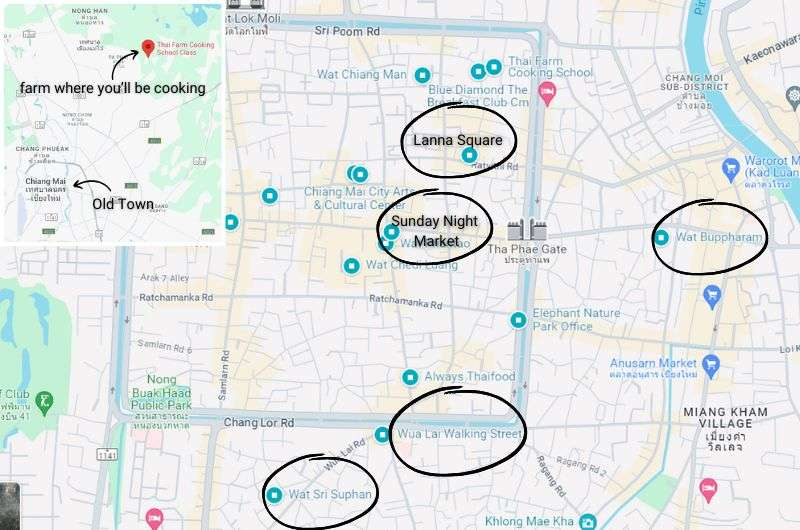
The places you’ll see on your 3rd day in Chiang Mai (starting with a cooking class way outside of town)
Main sites visited on day 3: Cooking class, Silver Temple, Wat Buppharam, Sunday night market nebo Lanna Square market on other nights (mention others like Wua Lai Walking Street, Chiang Mai night bazaar)
Restaurant tips: Today, you feed yourself! And dinner is at the night market
Hotel recommendations: CouCou Hotel
Further reading: Chiang Mai’s Best Temple
To kick off your 3rd day in Chiang Mai, we’re diving into Thai cuisine with a half-day cooking class—it’s an experience you need to have when in Chiang Mai. . But we’re not just talking about any old cooking class in the city. Oh no, we’re heading out to one of the charming farms surrounding Chiang Mai for a truly immersive experience.
Day 3, stop 1: Thai food cooking class (half-day)
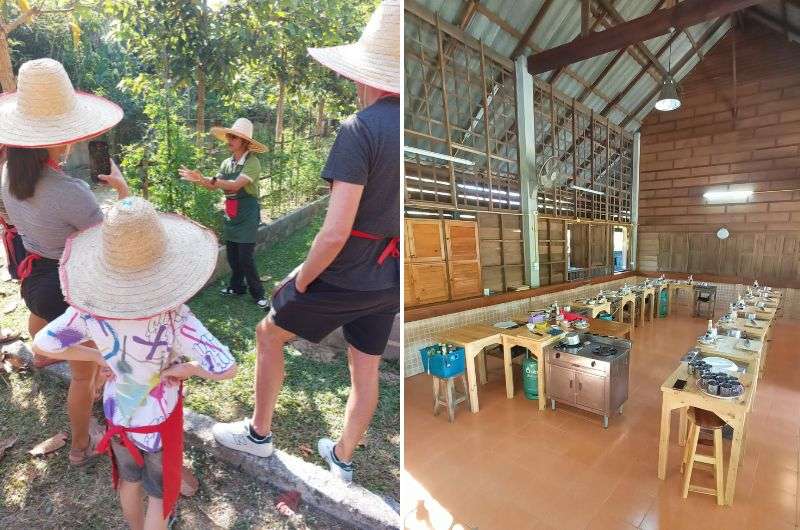
Tasting leaves of various plants in the garden before we start cooking (left); our cooking stations (right)
Time spent here: About 7 hours including transportation to and from the farm
Price: THB 1,200 for a half-day class at Thai Farm Cooking School (my favorite school)
Northern Thailand is renowned for its distinct and delicious cuisine, which differs significantly from the dishes found in other parts of Thailand. The region’s culinary traditions are heavily influenced by neighboring countries such as Myanmar, Laos, and China, resulting in unique and flavorful dishes.
And that’s why you’re kicking off your 3rd day in Chiang Mai with a cooking class! And I’m not just talking about any old cooking class in the city. Oh no, we’re heading out to one of the farms on the outskirts of Chiang Mai for a truly immersive experience. Don’t worry, beginners are totally welcome and everything is easy to make.
My preferred cooking class is from Thai Farm Cooking School, I’ve cooked with them twice now and can vouch for their high standards. They do full-day and half-day classes and I think half-day is enough. Make sure to book your morning class at least a few weeks in advance, because they do get fully booked.
Even if you choose a different cooking school with a farm outside of Chiang Mai, the setup is always similar:
First, a minivan makes its way around the hotels to pick everyone cooking that day up at around 8 am, so you may end up riding around town for a but if you’re first stop. Our minivan stopped at 5 hotels total.

Checking out the local market
Then the real adventure starts with a stop at a local market. Ours was way outside of Old Town, making it feel like a real market where real market things happen, and there were no souvenir stalls in sight. Lovely. Here’s a pro tip: the local rule is that you buy whatever you pick up, so resist the urge to touch everything! Our jovial guide walked us through the stalls, explaining the various ingredients and their uses in Thai cuisine, as well as alternatives you can use in your home country (since you can’t buy many of these things in Europe or the US). It’s a colorful, bustling place, and a great way to see where the locals shop. We found coffee, too, score!
Next, we hopped back into the van for a bumpy ride to the farm. Once there, we got our red aprons and nifty Thai hats and we toured the crops growing on the farm, tasting leaves and herbs of plants I’d never seen before, like the fragrant kaffir lime leaves and the spicy bird’s eye chili. This is what I appreciate on the farm cooking classes, it’s just another level beyond what you can experience in the city. I was even impressed with the very picky eater that is my 8-year-old son, chowing down on foreign leaves like he was a professional rabbit.
Then it was time to cook. Under the watchful eye of a cheerful instructor, we prepared five different dishes, each at our own cooking station. Kids can cook too. My son was an “assistant cook”, meaning he paid half price and didn’t get his own station, instead helping me out. We did get more ingredients to make sure we both had full portions of all the food. Older kids can obviously cook on their own.
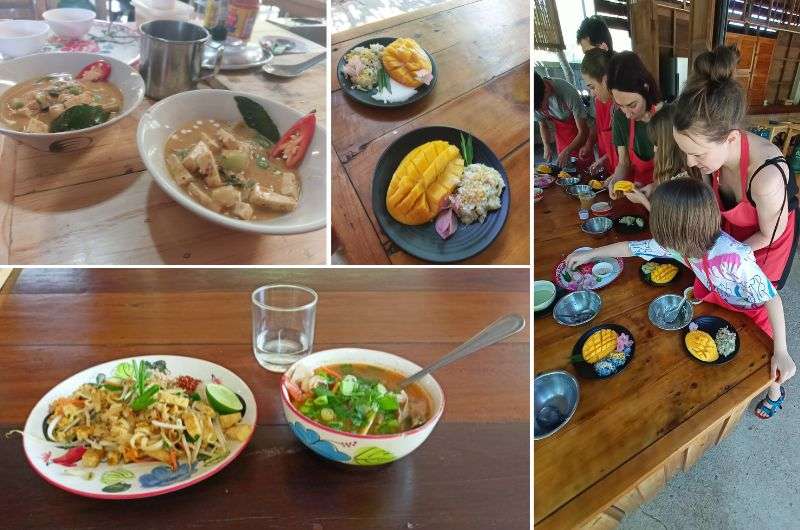
The results of our Thai cooking and the finale... mango and sticky rice! My favorite
Here’s a tip: pace yourself. You’ll be eating everything you cook, and by the time we got to the fourth dish, I was as stuffed as a teddy bear. Knowing that mango sticky rice was coming up, I was on a mission to save room in my belly. Yeah, yeah, I know, you can buy mango sticky rice everywhere, but there’s something special about making it yourself, you know? Plus, at Thai Farm Cooking School, you make either the blue or green variant, which is extra fun!
You’ll be dropped back at your hotel around 2 pm, stuffed and ready for an afternoon nap. But hold off on that because you are in no way done yet! Next up, let’s explore some more of Chiang Mai’s temples.
Day 3, stop 2: Silver Temple (Wat Sri Suphan)
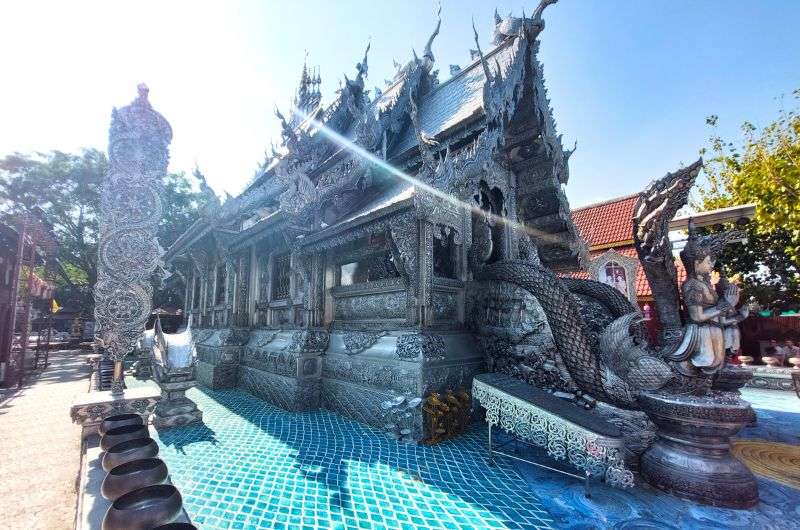
Wat Sri Suphan temple—unfortunately not accessible to women
Distance from last stop: Depends on where your hotel is
Time spent here: 20 minutes if you’re a woman, a bit more if you’re a man and can actually go inside
Price: THB 50
Silver Temple, officially names Wat Sri Suphan, is just outside the southern border of Old Town Chiang Mai. You’ll know you’re there when you see the glistening silver exterior. It sounds kitsch, but it was actually pretty cool, plus it’s a nod to the silversmith profession that’s a tradition in this neighborhood. The craft has been practiced here for centuries, and the artisans in this area are known for their intricate and beautiful silverwork.
Upon arrival, if you're not dressed in temple-appropriate attire, the ticket window provides wraps to borrow, ensuring you can still explore respectfully. Good thing for me, because I came here as a last-minute bright idea after a waterfall visit and was sporting shorts that definitely were not covering anything close to my knees.
You pay THB 50, get a free keychain and a ticket to pick up a free water in the nearby café. Wrapped up and hydrated, I strolled to the gleaming Wat Sri Suphan. Just kidding, I power-walked, hiding in any inch of shade I could find. 38-degree heat will do that to you (that’s 100 degrees for you Americans out there).
Women are banned from entering the temple itself, but there’s plenty to admire from the outside. The extremely detailed silverwork on the exterior walls includes scenes from Buddhist mythology and even a ton of surprising modern elements (hello, Marvel superheroes!).
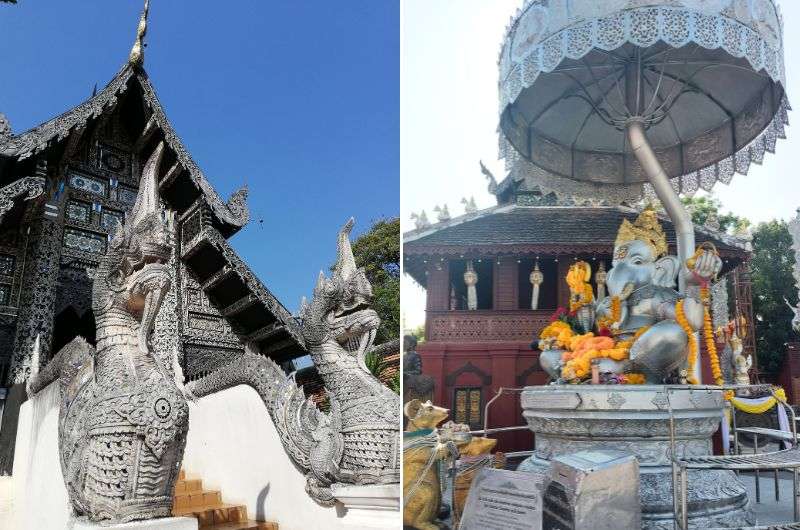
The statues around Silver Temple
The interior, which I could only peek at and see diddlysquat, is just as epic. The floor is designed like a map of the Earth, connected by the zodiac, with aliens happily exploring our planet. Seriously, they included everyone in these designs! The walls depict the Buddha’s life and other religious figures.
Make sure to also check out the silver souvenir stalls. I mean, the stalls aren’t silver, but they sell silver... Sometimes you can see the artisans at work, too. I got myself a snazzy silver bookmark.
Then there’s the main hall, which everyone has access to. Finally, some shade! This one is not silver at all, being fairly traditional in just about every aspect besides being festooned with colorful banners and baht bills during my visit. It was full of them!
Day 3, stop 3: Wat Buppharam
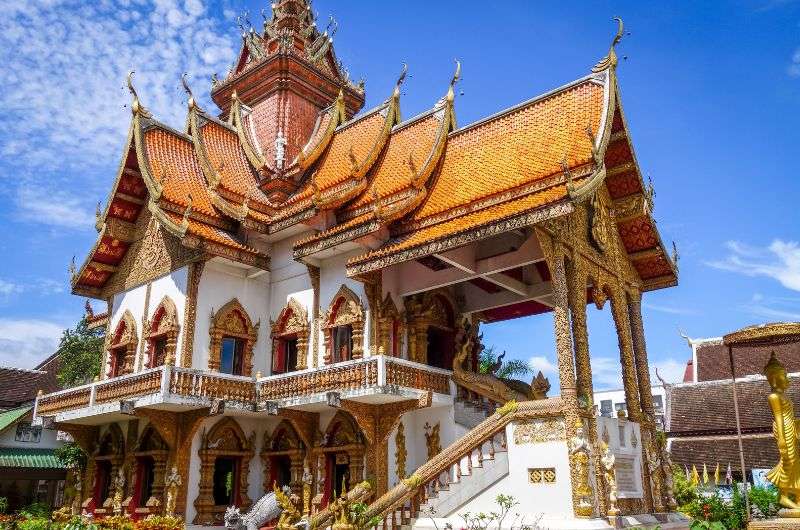
The Burmese-style chedi in Wat Buppharam
Distance from last stop: 3.5 km (2.2 mi), 10-minute drive, or a 2 km/1.3 mi 30-minute walk
Time spent here: 20 minutes
Price: 0
Next, head to Wat Buppharam. You’ll want to hop in a Grab for this, as it’s quite a bit away. Wat Buppharam is a small but incredibly detailed temple near the Warorot Market.
Tip: I’m not a huge fan of Warorot Market, or any other typical market for that matter, but you could add it to your itinerary now if it’s something you’re interested in. It’s large, it’s 3 floors of just stuff, it’s overwhelming, it’s a waste of time if you ask me. You’re going to the night market in the streets of Chiang Mai later on today, so that should do it as far as market fun goes.
Wat Buppharam is a visual feast, with intricate details and vibrant murals packed into a relatively small space. My knowledge of Thai temples is failing me right now, but I think it’s the dhamma hall that I’m talking about. It’s up a narrow flight of stairs, which itself is unique, and you might have to wait your turn to go up, but the detailed interior is worth the minor wait (you leave your shoes at the bottom of the stairs). Take your time to admire the details—you'll find something new every time you look around.
Then there’s the Burmese-style chedi that you can’t miss, and another temple building that had monks inside chanting when I visited, so I just peaked in and let them do their thing in peace.
Day 3, stop 4: Sunday night market on Ratchadamnoen Road (+ alternatives)

The best night market in Chiang Mai happens on Sunday nights only, but there are alternatives for every night of the week, like the Lanna Square market that’s on every night as far as I know (in this photo)
Time spent here: 1–2 hours
Price: 0 entrance fee, but you’re not leaving without buying anything!
No visit to Chiang Mai is complete without exploring the night markets, and the very best one is only available on Sunday nights, probably because it causes a disruption to traffic and blocks off half of the streets in central Old Town.
I’ll also give you some other options if you aren’t there for “the big one”.
Like I mentioned, I’m not a huge fan of markets, but the Sunday Night Market is fun and you need to go (though once may be enough). Very crowded, obviously, but fun.
The city starts closing off Ratchadamnoen Road and some side streets mid-afternoon, with a police person calling out for people to move their cars and scooters out of the area in regular intervals. The market officially starting at 4 pm and going until midnight. The earlier you get there, the better. By late evening, it becomes completely claustrophobic, with a dense flow of bodies that makes it hard to break away. So, aim to arrive early to avoid the worst of the crowds.
What to Expect: The market stretches from Tha Phae Gate almost all the way to Wat Phra Singh, covering a vast area. Don’t aim to see it all—it’s just too much, and some of it gets repetitive. Instead, wander and enjoy the experience. You’ll see stalls selling high-quality products like jewelry, paintings, and, in my case, pillow covers that now adorn my couch at home, but some of them just sell the same crap you can see in any of the regular markets around town.
The market is especially fun when you buy snacks to eat as you go. The only problem with that tip is the annoying is the lack of garbage cans and places to rest. We dared to sit down on a stair in front of an ATM machine by a currency exchange shop and got scolded for "blocking customers' view." Sure, buddy, that’s why they aren't piling in (we weren’t blocking it one bit!). So, be mindful of where you rest and dispose of your trash. And maybe don’t get fresh coconuts if you don’t feel like walking around with the coconut shell for an hour.
Several food courts are set up throughout the market—just follow your nose. You’ll find a wide variety of options, from traditional Thai food to unexpected treats like tacos and waffles. In case you’ve managed to digest everything you ate at your cooking class this morning, now’s the time to fill up again.
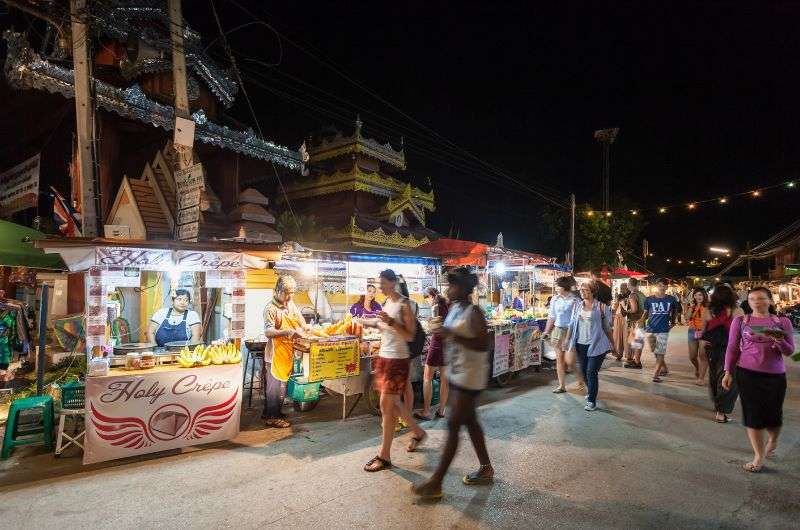
Night market in Chiang Mai
Sunday market shopping tips: Bring smaller denominations of bills, as most vendors don’t accept cards. You can negotiate gently, this isn’t a fight, people! Besides the market stalls, all the little shops lining the streets remain open late on Sunday market day, offering even more shopping opportunities. No negotiating there, obviously.
Sunday Night Market alternatives
- Lanna Square Market: If it’s not Sunday and you’re hungry, check out the Lanna Square Market. It’s there every night of the week and it’s just a small square lined with food stalls with a wide variety of food, with a stage in the middle. It seemed like a free-for-all, with a varied line-up of singers, musicians, and dancers of different levels of quality. Not professional, but definitely heart-warming and fun.
- Wua Lai Walking Street: On Saturday evenings, the Wua Lai Walking Street market is the place to be. Located near the Silver Temple, this market is known for its silver jewelry and handicrafts. Plus, the food stalls here are top-notch. It’s like a slightly smaller Sunday night market, just with more silver.
- Chiang Mai Night Bazaar: Open every night, the Chiang Mai Night Bazaar is a tourist favorite (not mine, but other people like it a lot apparently). It’s a sprawling market with endless stalls selling everything under the sun. And food.
Day 4 of Chiang Mai itinerary: A day at an elephant sanctuary
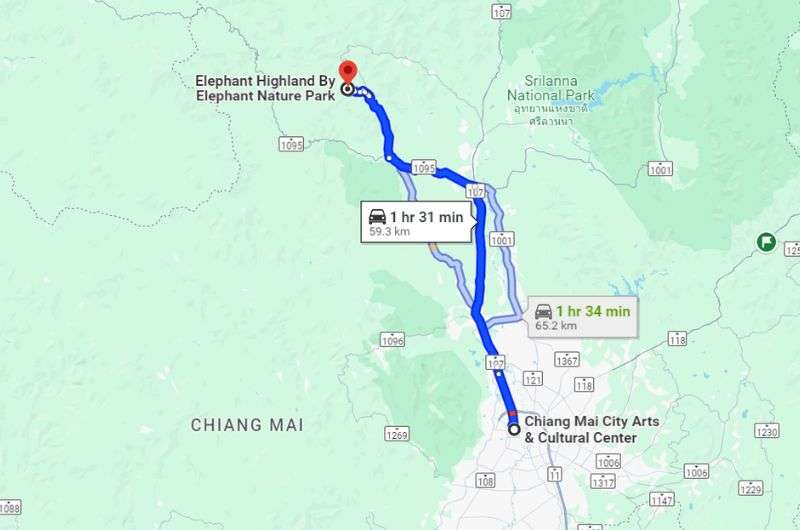
The route to what I think is the best elephant sanctuary in Chiang Mai
Main sites visited on day 4: Elephants!
Restaurant tips: Eat with the elephants (and hope you get the amazing papaya salad we did)
Hotel recommendations: Cou Cou hotel
Today you’re heading out for an unforgettable experience with some of Thailand’s most iconic creatures—elephants. Seriously, they’re like big, wise puppies, I just love ‘em and I bet you will too.
Distance from Chiang Mai: 60 km (37 mi), a 1,5-hour drive
Price: THB 6,000 (USD 165) for full-day Elephant Highlands experience offered by Elephant Nature Park
Duration: A full-day visit lasts roughly from 8 am–5:30 pm including transportation
Traditionally, elephants in Thailand were used for logging and tourism, often facing harsh and inhumane conditions. With the logging industry banned and ethical concerns about the tourism industry growing, sanctuaries have emerged as a compassionate alternative. Unfortunately, that also means that a huge number of “sanctuaries” are just another money-making machine that have a nice name that tricks tourists into visiting. Please do your research before visiting any elephant parks in Thailand. The elephants will thank you, and that’s a BIG thank you!
Choosing the right elephant sanctuary
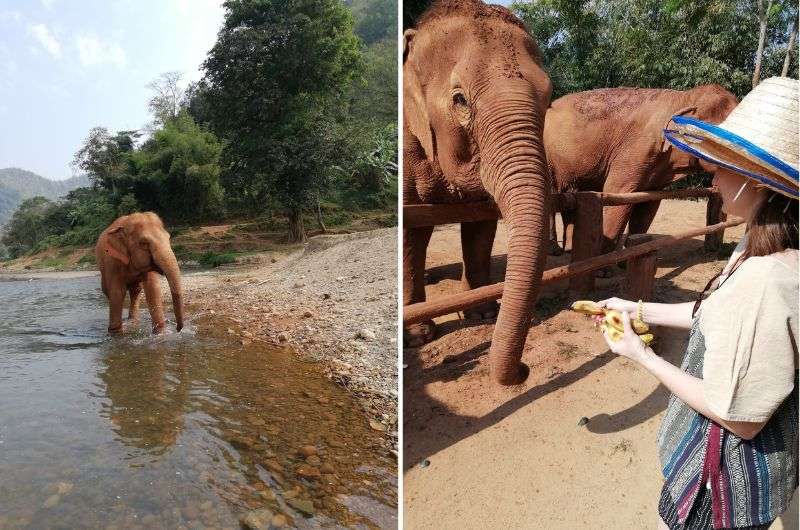
The best elephant sanctuary in Chiang Mai is Elephant Narure Park. They even have us some nifty clothes (not sure why I’m wearing two hats)
If you follow my suggestion, you’ll be visiting the best and most renowned sanctuary in the region, Elephant Nature Park (no affiliation, they just have a long-standing record of ethical treatment of elephants). Maybe somewhat surprisingly, I’m not suggesting you visit the main sanctuary, but rather a much smaller project protected under the sanctuary’s wing… Let’s dive into the details:
Elephant Nature Park, founded by the incredible Lek Chailert, is a true heaven on Earth for elephants. Lek, often referred to as the “Elephant Whisperer,” has dedicated her life to rescuing and rehabilitating elephants from abusive situations. I’ve seen some videos of the situations that these elephants have been taken from, and it’s not for the faint of heart. Most of the rescued elephants are brought over to Elephant Nature Park’s main sanctuary, which you can visit on half-day, full-day, or overnight trips.
Why not to choose the half-day option
I wouldn’t go for any of the half-day experiences because you’ll spend at least 1.5 hours on the road each way, and then you barely feed a few elephants, stare at them from a distance for a while, and you’re already on your way back to Chaing Mai. Definitely choose the full-day experience if you choose to go to the main park, because that way you get to care for and walk with the elephants more.
The main park is located in the Mae Taeng district, about 60 km (37 mi) north of Chiang Mai. It’s a beautiful area, surrounded by lush greenery, where all you can hear are the sounds of nature.
But that’s not the only place you can visit. Elephant Nature Park also operates several smaller projects, like the Elephant Highlands, which offers a much more intimate experience. Sure, you only get 3 elephants and not hundreds wandering around, but I’m mainly concerned about how many other tourists are crowded around me, and this was bliss with just a small group.
What to expect during a day-visit to the elephant sanctuary
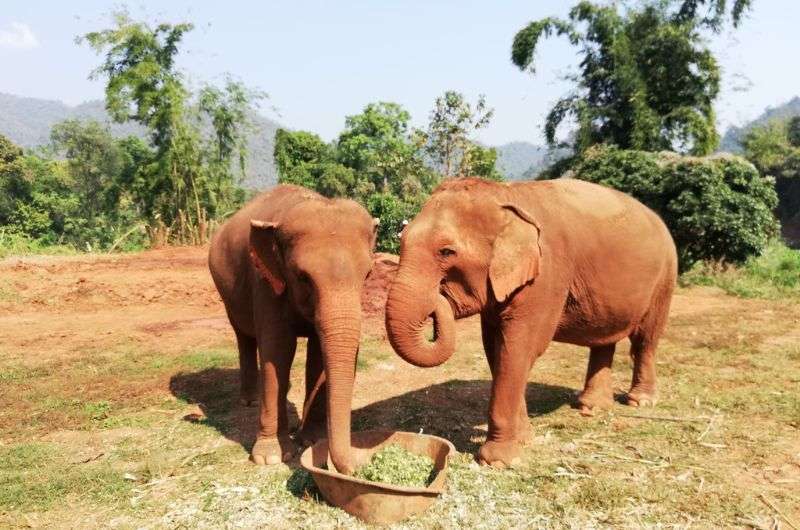
You can expect a wonderful time with these big puppies
The Elephant Highlands Experience offers a full-day trip for THB 6,000 per adult (50% for kids). Get ready to really be with the elephants—you need to be able to walk for 3 hours, sometimes in mud, sometimes up hills.
Once at the small sanctuary, we met 3 elephants, including one adorable granny elephant who stole everyone’s heart. In the wild, elephants of her age would typically die because they lose their teeth and can no longer feed themselves. Here, we peeled her bananas and cut the rind from watermelons, making sure she could enjoy her food toothless. She was a happy, perky lady, and it was a joy to see her so content.
We took part in these activities:
- Feeding the elephants: Since we were such a small group, we weren’t getting in each other’s way, and nobody felt the need to hog an elephant. Just grab a banana or watermelon (which we first had to chop up), pick an elephant to feed, and go for it. Repeat until you run out of fruit.
- Medicine balls: We also made medicine balls out of a gooey concoction to help keep the elephants healthy. It was messy but fun, and the elephants loved them.
- Lunch: We proceeded to make lunch for ourselves, being taught how to make a yummy papaya salad (we make it at home often to this day!). There’s an outdoor dining area with views out into the land, so although you’ll miss the elephants for 30 minutes or so, you’ll at least enjoy northern Thailand’s nature for a bit.
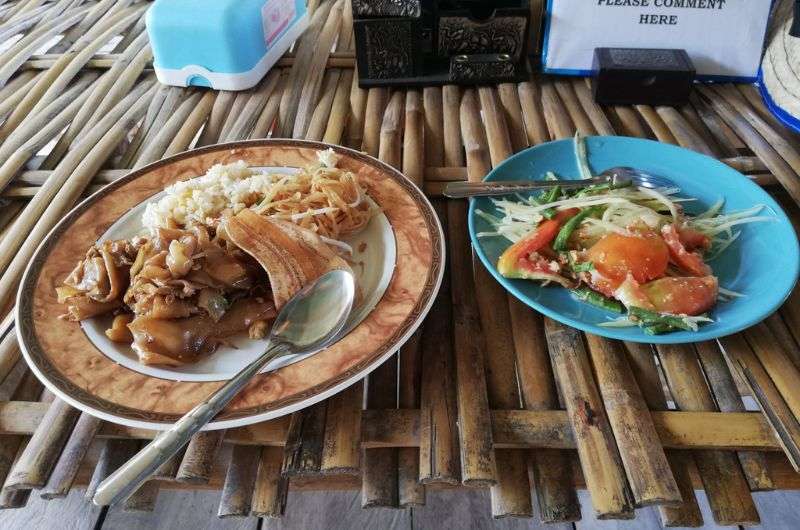
Yummy!
- Jungle Walk: We walked through the jungle with the elephants for close to 3 hours, staying right by the elephants in some parts and giving them a little more space in others. It was fascinating to observe their natural behaviors in a more relaxed setting—this would not be possible in the main park unless you choose one of the long programs. Again, being a small group of humans was so nice, and the elephants were really left to go at their own speed and stop for snacks whenever they wanted.
- Mud Spa: Finally, we watched from a respectable distance as the elephants enjoyed a mud bath in their little spa area. They rolled around and covered themselves in mud, which protects their skin from the sun and insects. They trumpeted happily, too. Again, they’re just big dogs (not that dogs trumpet or anything)!
Warning about other sanctuaries
I highly preferred the Chiang Mai elephant experience to another elephant sanctuary I had visited this year near Krabi in Southern Thailand (it won’t be included in my Thailand itinerary, that’s for sure!), where droves of tourists actively participated in every little thing the elephants did. Every time one of them moved an inch, twelve humans moved with them. They were absolutely lovely, but I had secondhand annoyance for the elephants, and was a upset about not finding out about this before going (you really need to dig for the negative reviews!). They really don’t need bikini-clad, squealing humans assisting them in throwing mud onto themselves.
To think they do this twice a day, every day, was a huge letdown. So, no, simply just not riding elephants isn’t enough to constitute ethical treatment; it’s giving the elephants space that is important, too. Of course, riding elephants, elephants “voluntarily” playing football, painting, or doing tricks are big no-nos.
That’s why I recommend Elephant Nature Park and its projects, because they’re first and foremost focused on the well-being of the elephants, putting human enjoyment second. Basically, the less you are allowed to do with the elephants, the better.
There are dozens of sanctuaries in Chiang Mai province alone, so you aren’t lost for choice, but making the right one really matters.
Day 5 of Chiang Mai itinerary: Day trip to sticky waterfalls and Chiang Dao
Follow this route on Google Maps to complete your last day in Chiang Mai—day trip to Sticky Waterfalls and Chiang Dao
Main sites visited on day 5: Sticky Waterfalls, Wat Tham Pha Plong, Chiang Dao rice fields
Restaurant tips: Khampunna Café resort & Nature café
Hotel recommendations: G Nimman
Further reading: Chiang Mai’s Best Temples
Another day, another day trip from Chiang Mai! A waterfall that you can walk up like you have gecko feet, incredible mountains, bright rice fields, a temple with views for days, and… coffee! Good coffee is like the cherry on top on any trip, isn’t it? Not sure about you but that sounds pretty epic to me for your last day in Chiang Mai.
I’ve added a section about renting a car in Chiang Mai at the end of day 5 just to give you all the info to help you out with this endeavor. It’s not as scary as it may seem if you’re in Thailand for the first time!
Day 5, stop 1: Sticky Waterfall (Namtok Bua Tong-Nam Phu Chet Si National Park)
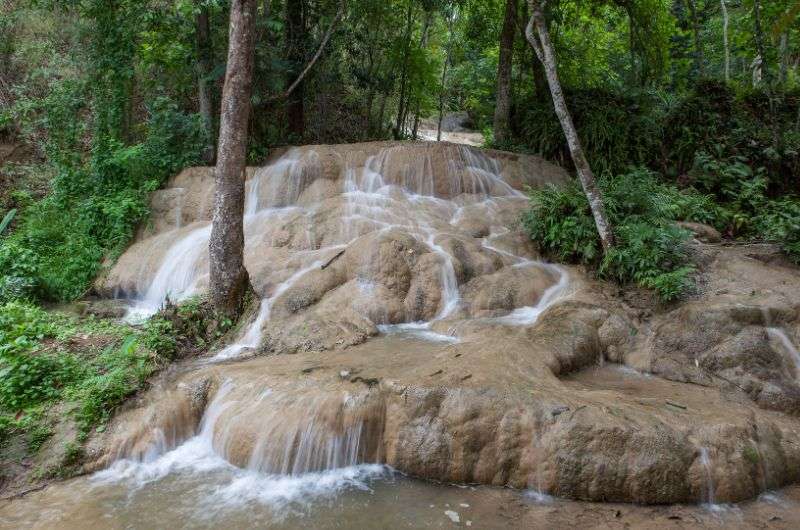
Sticky Waterfall!
Distance from Chiang Mai: 57 km (35 mi), a 1.5-hour drive
Time spent here: 1.5–2 hours
Price: 0
First up on your itinerary today is the intriguingly named Sticky Waterfalls. Officially called Namtok Bua Tong-Nam Phu Chet Si National Park (try saying that three times fast!), I was skeptical to visit because it sounded like tourist trap, but it was great fun. The waterfalls are unique because of the mineral deposits that make the rocks "sticky," allowing you to climb them with ease. And so, we did.
Just seeing the falls isn’t enough, so get ready to get wet—you’ll be walking up the falls straight through the water gushing down—and there’s a lot of it! And you’ll stick to the rocks like Spiderman!
Go early! It’s like a waterpark, but all-natural, and it’s great fun despite being completely flooded with tourists—the earlier you get there the better chance you have of not having to deal with crowds (it’s the Chinese ones that are, err, so very inconsiderate! Sorry, not sorry, it’s just facts).
The drive from Chiang Mai takes about 1.5 hours. Once you arrive, you’ll be greeted by a huge parking lot (free), and then a lush forest and the sound of cascading water pretty soon after. The park is well-maintained and has facilities like restrooms and picnic areas. There’s no entrance fee.
What to do at Sticky Waterfalls
You can’t miss the falls. When you get to them, you’re above them, so you first take off your shoes and proceed to walk down the wooden stairs and walkways for about 5 minutes—beware the dark wood gets very hot! Some people preferred to walk down in their shoes and then stuff them in their bag instead for this reason. I preferred to burn the bottoms of my feet, god knows why, I guess to prove I can do it.
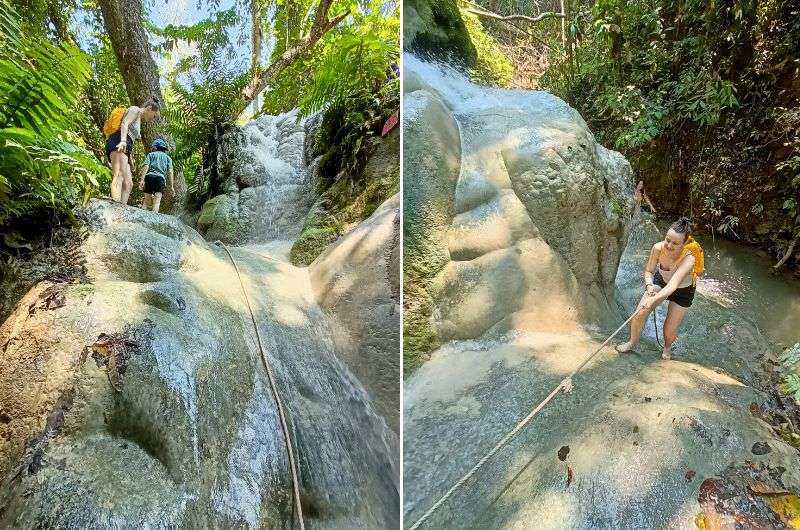
Time for a little adrenaline
Then, climb the waterfalls! Before you start, you aren’t sure if they’ll really be sticky enough to carry you, because these falls are steep! But sure enough, you just go against physics and walk up the falls like you’ve been doing this since you were a little kid. The sticky limestone rocks provide excellent grip, and you can see in some sections they scrub whatever green stuff tries to grow on it to take the stickiness away—it’s not perfect tough, so be careful.
I have to say the Sticky Waterfall is smaller than I expected, but also steeper than I expected. You’ll need to use ropes in some sections to help pull yourself up, and sometimes I felt safer having a hand on the ground in case I slipped. But you can climb/walk up the Sticky Waterfalls in 20 minutes if you’re in a rush, but why would you be? There is more than one route you can take in two places, so take your time and enjoy this unique experience! We ended up doing the whole thing twice and laughed like children the entire way. Except when we got stuck in the middle of a group of tourists from you-know-where. Some people… sheesh.
What to wear
Many families make a day of it, so expect kids and adults hanging out in their bathing suits going up and down over and over. Otherwise, there’s no need to get dressed in anything special, just wear shorts on your bottom half, because your legs will get entirely soaked. If you don’t fall on your butt, you can walk up the falls without getting your clothes wet aside from a few splashes.
Other activities at Sticky Waterfalls
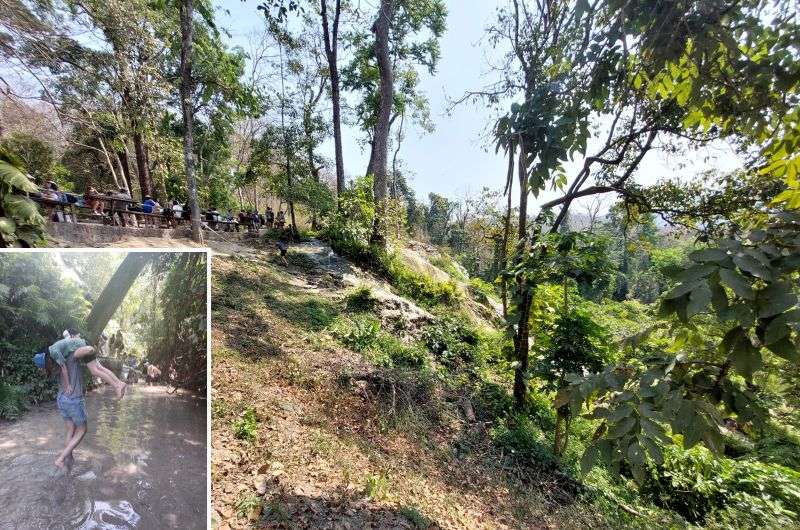
The Sticky Waterfalls trail is pure fun! Don’t forget to take someone with you who will carry you through the water if you're on the short side! Large photo shows the top of the falls
There’s also a short nature trail at the falls. The trail winds through the forest, offering a peaceful walk surrounded by nature’s beauty. You’ll come across various plants and wildlife, which may be a nice change after being surrounded by noisy tourists for the last 30 or however many minutes you stayed in the falls.
Otherwise, you can eat! Food’s always a good idea, no? There’s a drinks bar and a small and very busy food place, both right by the parking area. If you get there when it’s full, be prepared to wait for your food. They have a system where you get a number when ordering and they call out the numbers as the dishes are made ready. It was funny that they had their kids helping with this part of the serving process and sometimes the poor things were wandering around, plates in hand, for quite some time before somebody admitted to having the number they were quietly shouting out.
Day 5, stop 2: Wat Tham Pha Plong in Chiang Dao
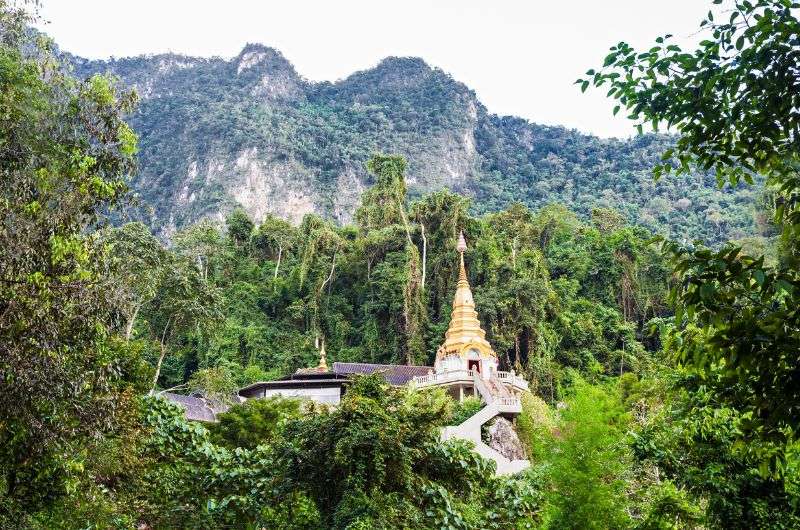
Wat Tham Pha Plong—the hidden temple in the woods
Distance from last stop: 58 km (36 mi), a 1-hour drive
Time spent here: 30 minutes for just Wat Tham Pha Plong, extra time if adding the other temples as well
Price: 0
Next, hop back into your car and drive 1 hour further north to a temple nestled in the hills of Chiang Dao. It’s an uneventful and easy drive, mostly on a highway or similar road, passing some towns on the way. What does get interesting are the trucks that you pass that are small but mighty! They carry piles of who knows what stacked up waaay higher than you’d ever believe is possible! It’s amusing.
You’ll pass the overrated Big Tree Alley once you’re near your destination—it’s just a bunch of tall trees and a hilarious number of people in the middle of the road trying to take a photo with them. Then, there’s Wat Tham Chiang Dao and Wat Tham Pakpiang, both optional extra stops. Maybe decide if you want to see more cave temples once you’re done at the main site: Wat Tham Pha Plong.
First, visit Wat Tham Pha Plong, a temple at the foot of Doi Luang Chiang Dao, Thailand’s 3rd highest mountain. It’s accessible via a scenic staircase lined with Buddhist proverbs. The climb is peaceful and meditative, since you’ll be climbing up roughly 500 stairs to get there, which can seem like twice as much in the humidity and heat of Thailand. The journey really is at least as good as the destination in this case, because walking up to the temple offers up stunning views of the surrounding forest and mountains.
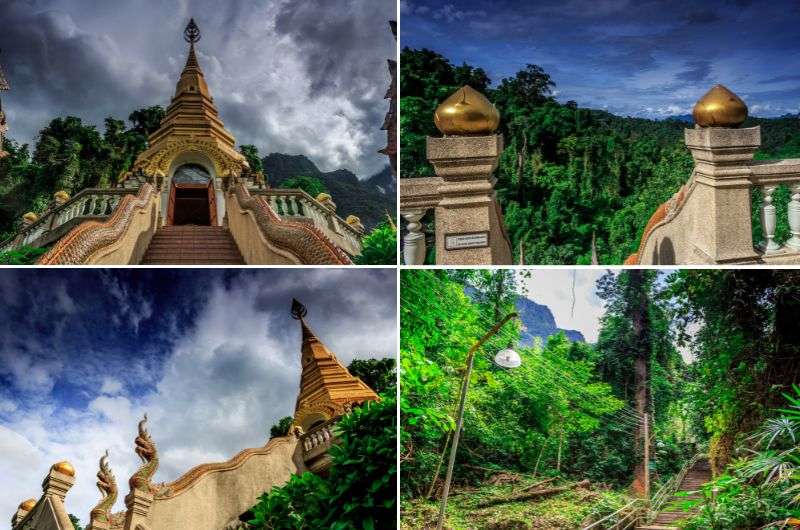
Getting to this temple is part of the fun, with great nature and scenery surrounding you on the way up the mountain
Chiang Dao is a city known for its impressive limestone mountains and caves, and being so far up north, has a much more local vibe than Chiang Mai. The name means "City of Stars," and it’s easy to see why when you gaze up at the night sky here (well, you won’t on this itinerary, but there’s always next time, right?). Doi Luang Chiang Dao, looming majestically above the landscape, is definitely a stunner.
There’s no entrance fee to go to Wat Tham Pha Plong, but you can make a donation. The temple itself is built into a cave, adding to its mystical atmosphere. The pagoda is currently under construction, but in true honesty, it doesn’t really matter because the highlight is the fact that you’re in the middle of nature and get fantastic views from the staircase and from the terraces on top. It’s a place that makes you want to be quiet, so as not to ruin the peaceful atmosphere. The proverbs you read on your way up help keep to yourself and just be.
If you loved Wat ThaP ha Plong, make sure to stop by the other two temples nearby to get all the cave temple urges out of your system.
Day 5, stop 3: Unexpected coffee stop in the middle of the rice fields
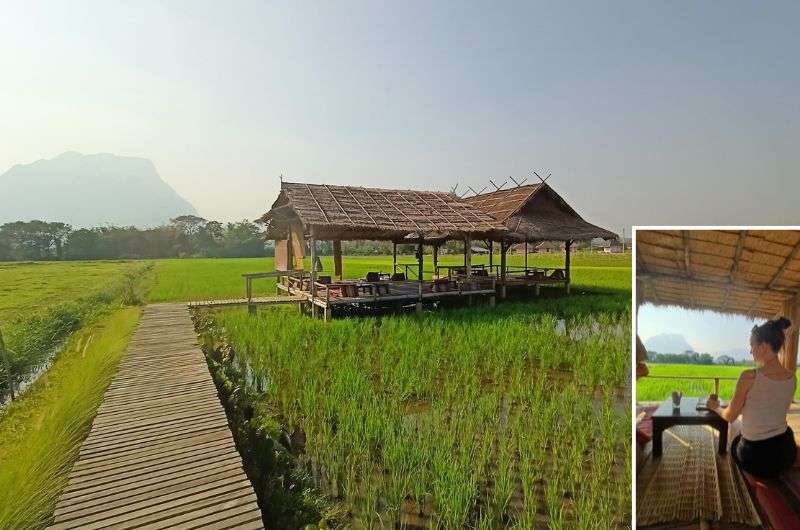
Beautiful café in the middle of the rice fields!
Distance from last stop: 11 km (7 mi), a 20-minute drive
Time spent here: 1 hour
There are plenty of places to grab lunch in Chiang Dao town or on the road from the temple, but once you fill your belly, make sure to leave room for dessert and coffee and head to the rice fields to the east of Chiang Dao for a proper rest stop.
We discovered this place almost by accident, and almost didn’t get there, because the “road” made me fear for our car’s chassis. But hey, if we made it, so can you! Luckily, the bumpy dirt road is just at the very end before you get there. Where is “there”? Khampunna Café resort & Nature café, in the middle of a rice field, super nice place with super nice, English-speaking owner, very attentive and professional. Basically, not at all what you’d expect in the middle of a rice field.
The coffee at Khampunna is excellent, and I highly recommend trying the brownies—they’re divine! You order at the bar, but they bring everything out to you if you decide to sit in the covered terrace area our in the field. You’ll walk to the terrace along a raised bamboo pathway, adding to the charm, and probably see locals working in the fields, too. Sitting in the middle of a sea of green rice while sipping unexpectedly good coffee felt a little wrong when others were slaving away in the intense sun, but it was so nice to just sit and relax for a bit.
When you add Doi Luang Chiang Dao looming above it all, it’s a picture-perfect stop before heading back to Chiang Mai.
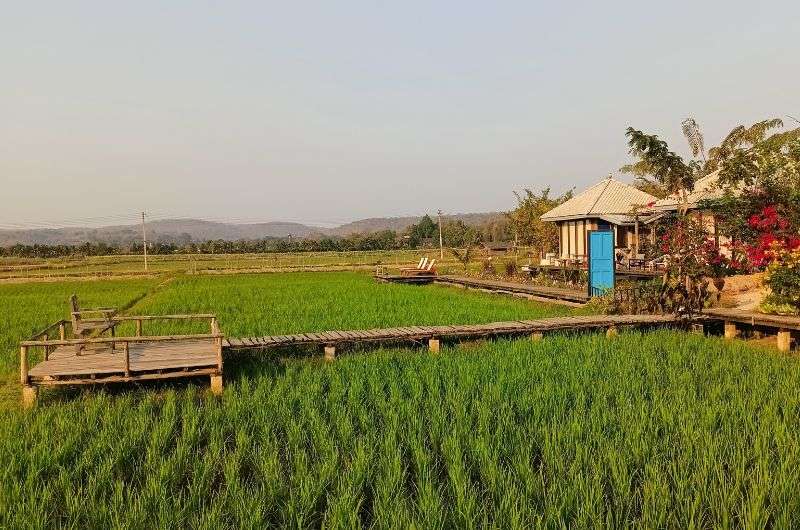
Loved it!
Tip: If you’re visiting in burning season, don’t expect clear views of the mountains. We went in March and say just silhouettes, but I still thought it was a fabulous sight.
Tip: If you ever decide to extend your stay in northern Thailand, perhaps making a road trip loop like we did, definitely check out Khampunna’s two rooms that have views straight out to the fields and mountains as well. I can imagine staying there must be incredibly peaceful and a lovely experience.
When you’re recharged and drank all the coffee you can manage, it’s time to head back to Chaing Mai. Expect a drive about 1.5 hours long over 75 km (46 mi). Your 5 days in Chaing Mai has come to end.
Where to next?
Well, Bangkok is a clear option. You either love it or hate it, and I love it! Or if you’re more of a beach bum, how about a couple of days on Koh Lanta?
Renting a car in Chaing Mai (and a bit about driving in Thailand)
To fully enjoy this day trip, I recommend renting a car. Here are some tips and insights to help you navigate the roads of Northern Thailand:
Driving on the left: In Thailand, you’ll be driving on the left side of the road, which can be daunting if you’re not used to it. Starting out in the busy traffic of Chiang Mai can be challenging, but once you’re out of the city, you’ll find it much more manageable. Just look out for scooters, mainly in the city, and you’ll be fine. As the bigger vehicle, you’ve got the right of way anyway.
Expect the unexpected: Thai roads are full of surprises. Here’s a quick list of things you might encounter:
- People driving in the wrong direction (mainly to get to a gas station, house, or store that would otherwise require a long detour to turn around lawfully);
- Vehicles driving unnaturally slow or fast;
- Sudden lane changes and cutting in front of you;
- Stray dogs wandering onto the road (they are experts though! I can’t imagine my dog crossing the road in any traffic, but in Thai traffic?!);
- Trucks piled high with precarious loads!
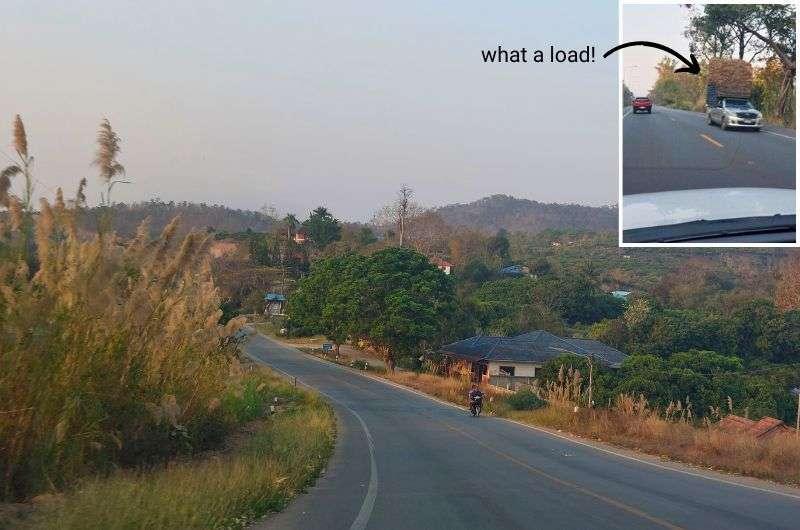
Driving in Thailand, outside of cities, it pretty easy if you can remember to stay on the left side and aren’t shocked by random peculiarities on the road
Car rental company recommendation: We used and can strongly recommend BudgetCatchers in Chiang Mai. We used the Nimman branch because it was in the direction of the road to Chiang Dao and meant less time driving in the city. They speak the best English I encountered during our entire Thailand trip, which was a relief. Everything was explained clearly, and the cars were all new and clean, costing from about THB 1000 per day. We chose the option to return it at the airport because we had a flight out to Krabi next, and I think we didn’t pay anything extra for this. Even if we did, it was smooth sailing and great service, so I wouldn’t have minded.
Choosing the right car: We opted for one of the cheapest options, thinking we didn’t need anything fancy for our adventure. Well, do you know what else you have to do if you want to stare out at the mountains in Burma (we did a longer loop)? Drive up the mountains in Thailand! Not an easy task if your car has a 1.2-liter engine! The poor little guy barely made it up some of the steep slopes—I was ready to jump out of the car and push it up there!
A note on driving scooters in Thailand: Riding scooters is something everyone seems to do on their first trip to Thailand, but beware: most tourists on scooters are riding illegally. You need a motorcycle license to be on a scooter, guys! Around Chiang Mai, the police have learned that most tourists don’t actually have such licenses, stopping and fining them happily all around the Old Town. So, beware and don't be stupid. If you do go on a scooter, wear a helmet and hope for the best. The issue is that if you're in an accident, your insurance won’t pay for anything, and as a rule of thumb in Thailand, whenever there’s a foreigner involved in an accident, it’s the foreigner’s fault. You’ve heard about Thai jails, right? Yeah, let’s avoid that.
FAQ 1: How many days do you need in Chiang Mai?
You need at least 3-5 days in Chiang Mai to truly experience its charm. It sucks you in, I tell you! With so much to see and do—from exploring temples and visiting waterfalls and elephants to venturing into the mountains—this city deserves more than just a quick stop. Plus, you’ll need time to recover from all the amazing food you’ll be indulging in! Northern Thailand is also cheaper than the south, so your money stretches a lot further up there.
FAQ 2: What is the best month to visit Chiang Mai?
The best months to visit Chiang Mai are November to February. This is when the weather is somewhat cool and the city hosts the spectacular Loy Krathong and Yi Peng festivals. Picture thousands of lanterns lighting up the sky—it's magical! Avoid the burning season (February to April) if you value your lungs and visibility. These months are also the hottest. On the other hand, if you don’t mind some rain, June to October are low season, but there’s nothing wrong with it except for higher chances of rain. Less crowds might be worth it though!
FAQ 3: Why is Chiang Mai so popular?
Chiang Mai is popular for its rich culture, stunning temples, and proximity to nature. It’s the perfect blend of ancient history and modern comforts, with a laid-back vibe that makes it hard to leave. And let’s not forget the surrounding mountains and jungles offering endless adventure opportunities, like hiking, great views, and ‘hidden’ temples. I wrote an entire article just about the top temples in Chiang Mai.

Chiang Mai is a lot of history, but you’ll often be reminded you’re in the 21st century. This was taken in the northern alleys of Old Town
FAQ 4: What food is Chiang Mai known for?
Chiang Mai is known for its delicious Northern Thai cuisine, especially Khao Soi—a rich, creamy curry noodle soup that’s absolutely to die for. Don’t miss mango sticky rice, my personal obsession. It’s a dessert, but since it’s with rice, it’ll fill you up pretty well! Yes, there’s an entire world beyond pad Thai waiting for you.
FAQ 5: How long does Chiang Mai burning season last?
Chiang Mai’s burning season typically lasts from late February through April. The Thai government has banned the burning of fields, which seemed to have made the situation a bit better in 2024 as far as I could tell. However, if you expected all the farmers to adhere to this new rule, you’d be wrong. We clearly saw more and more burned fields the further north we drove. Also, there’s no stopping the smoke from Laos and Burma from crossing the Thai borders, so... it’s still a smoky affair, and views are definitely limited. People in Chiang Mai have to resort to wearing face masks. Covid flashbacks, anyone?
FAQ 6: Is Chiang Mai a small city?
Given how popular Chiang Mai is, you’d think it’s a massive city, but no. It’ll be just you and less than 200,000 other people (including about 30,000 expats). Not too bad, right? Those 1.2 million foreign tourists will blend right in! Not to mention another 3 million local tourists annually… Is it getting hot in here or is Chiang Mai crowded?? Actually, it’s fine, if you’re not in the very center of Old Town in the area around Wat Chedi Luang. That’s a place you want to stick around for the shortest time possible unless you love rubbing sweaty shoulders with, well, everyone that’s there at the same time.
This post contains affiliate links. I earn a small commission if you make bookings through my links, at no additional cost to you. Thank you for your support!


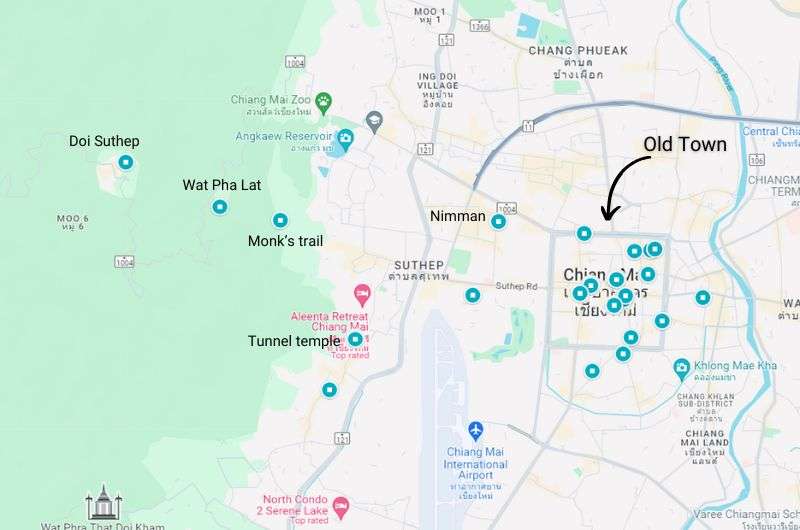
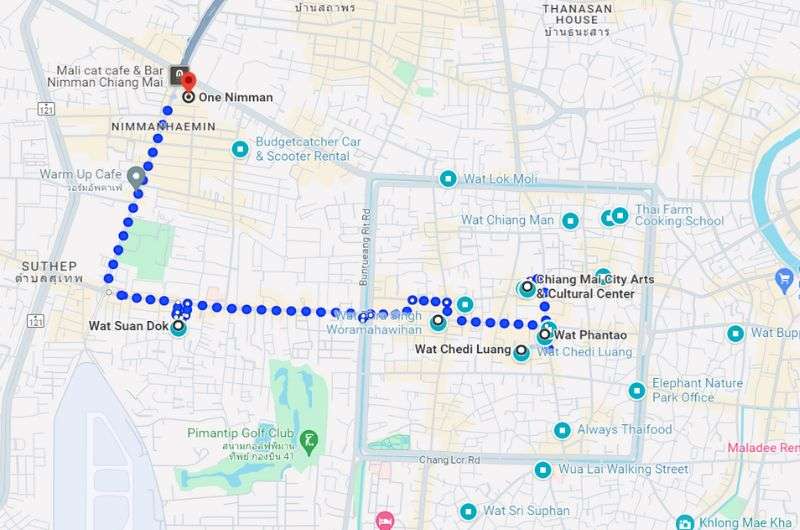
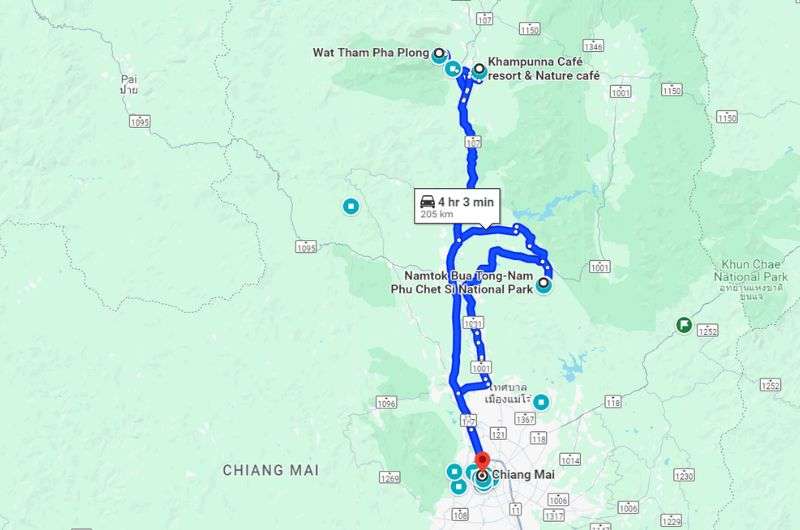

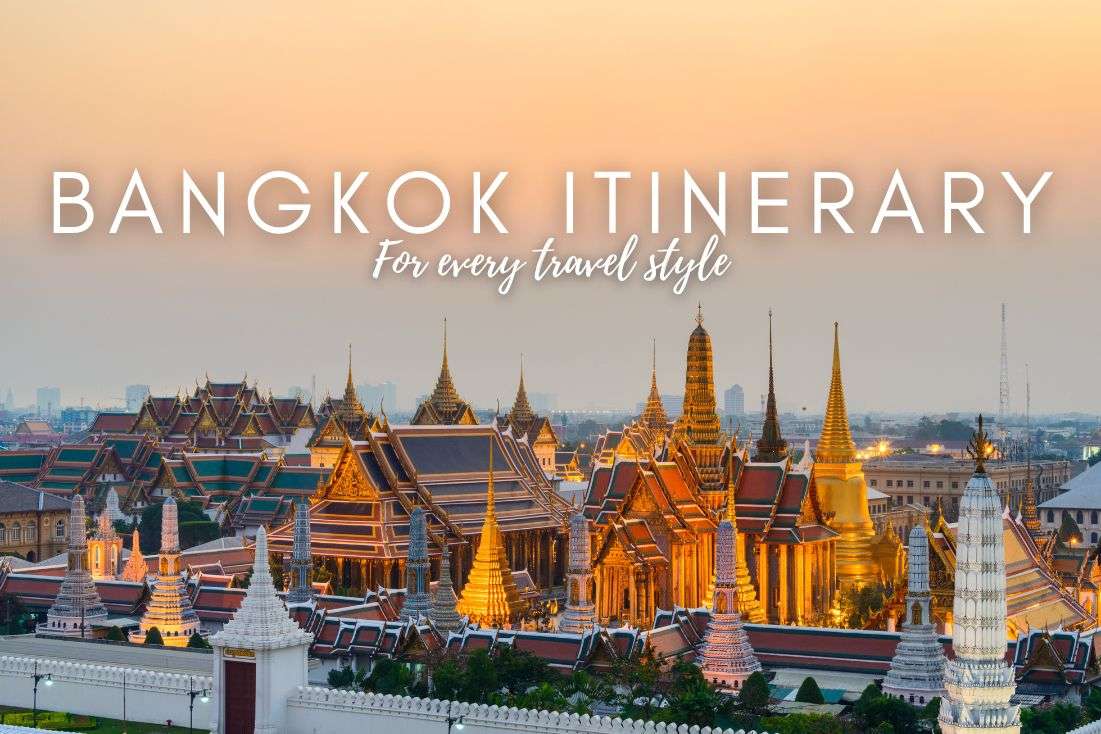
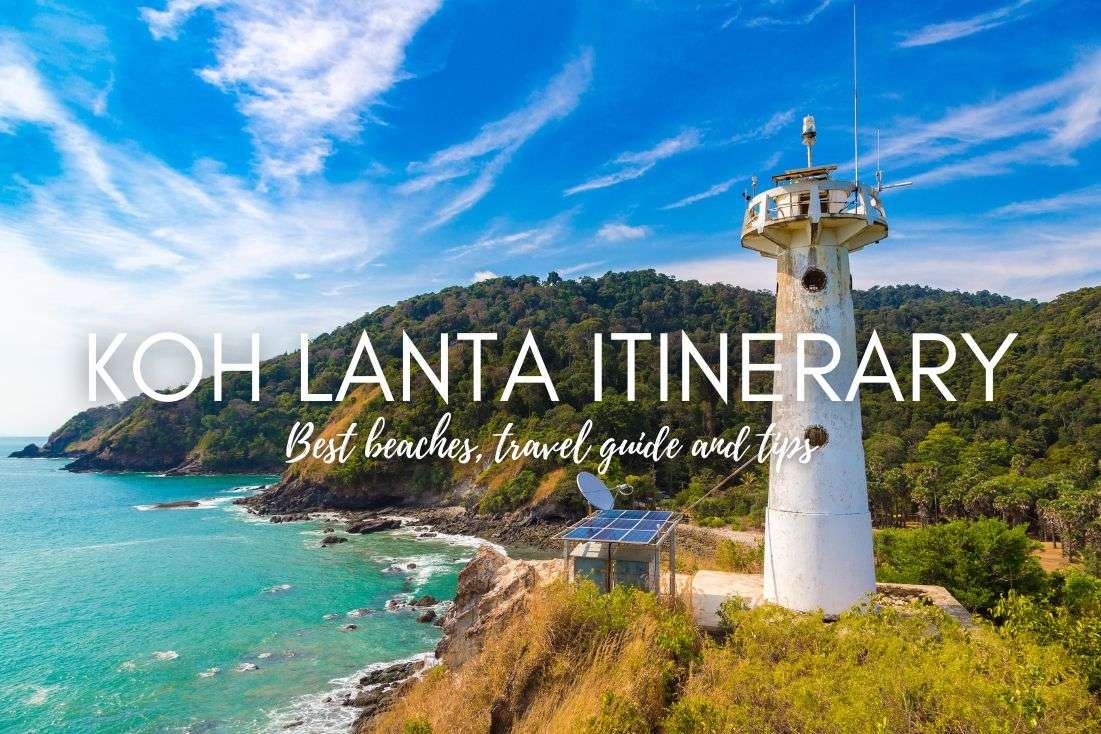





Comments | Thoughts? Give us a shout!